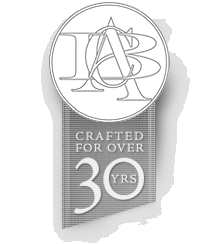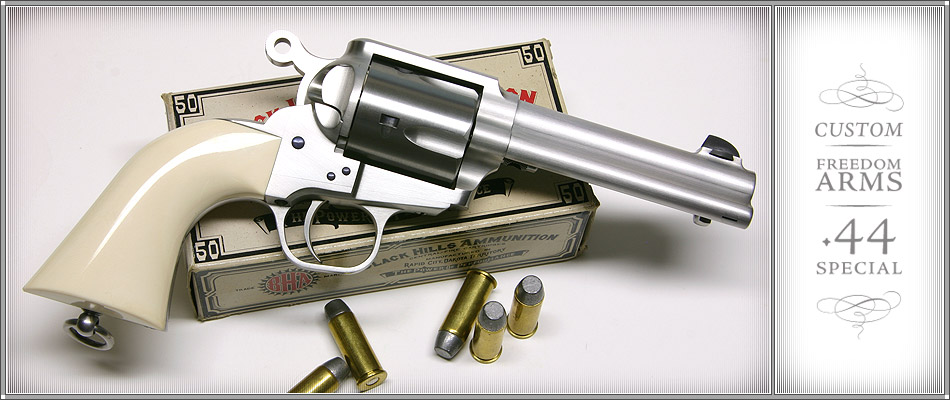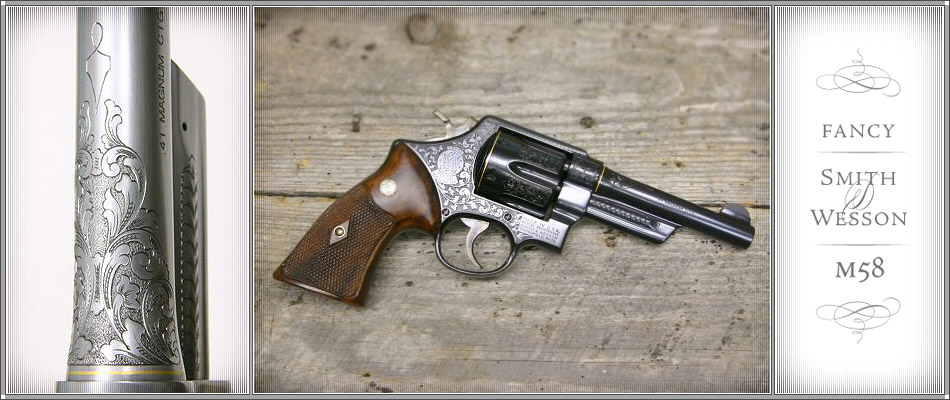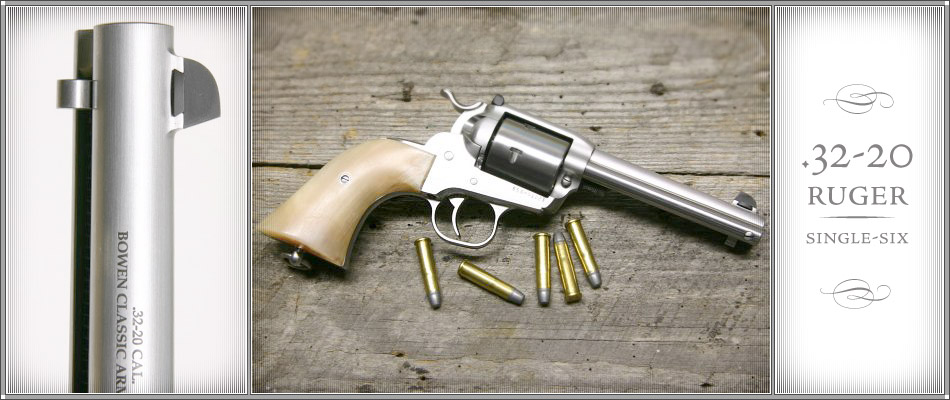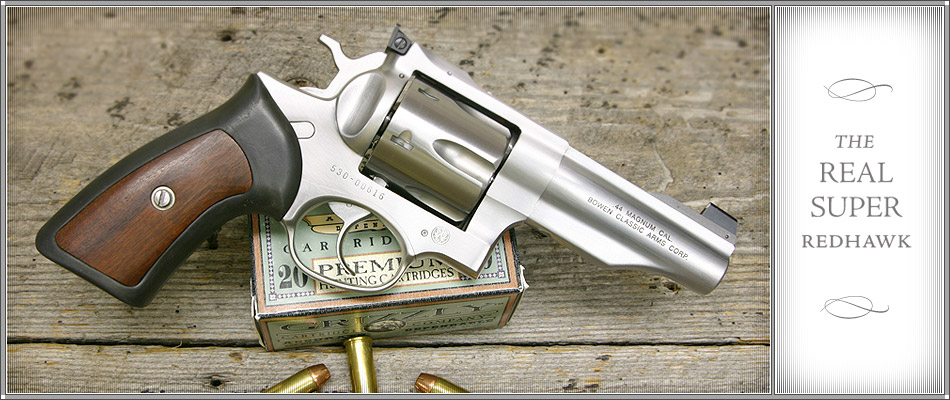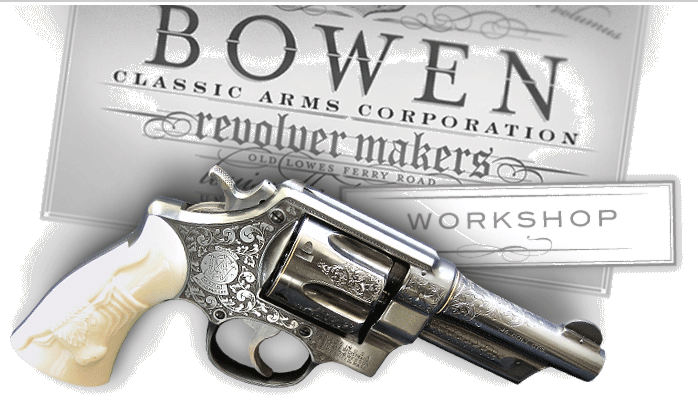
From time to time, we complete a gun that is a bit out of the ordinary—rarely a cataloged item, perhaps an experimental piece that didn’t warrant further investigation, maybe a restoration project or just something that excited us enough to share it. Most of these guns belong to clients, but occasionally we’ll be doing one for the shop. Those offered for sale will be identified as available and listed at the For Sale section of the site. Regrettably, these guns are few and far between these days but we’re striving to get some interesting projects completed and presented here.
A Couple of Single Sixes of Note
BLUE RUGER .44 MAG REDHAWK W/ANACONDA BARREL
Fancy USFA Flat Top Target
Ruger Super Redhawk with S&W-Pattern Barrel
Ruger.22 Rimfire Nimrod
Ruger GP100 with Python Barrel
Ruger Single Six Flat Top
Anaconda Barrel Installations on Redhawks
Colt Style Windage Adjustable Rear Sight
Grooved Octagonal Barrels
Matched Pair of Fancy .45 Flat Tops
USFA Light Weight SAA
Fancy Smith & Wesson .45 Colt Heavy-Duty Model
Ruger Redhawk with 4-IN. SP-style Barrel
.475 Ruger Bisley with Custom S&W-style barrel
Ruger Bisley with Ovate-form Barrel
.500 Ruger Redhawk with SP-style Barrrel
.45 Ruger Bisley with a S&W Barrel
Old Model Ruger Bisley
Custom Freedom Arms .327/.32-20
Custom Freedom Arms .44 Special
Small-bore S&W K-frame Caliber Conversions
Retro .38-40 Vaquero
Keith No. 5 style Ruger Blackhawk
Colt New Service .45 Colt Custom
Best Quality .50 Special Ruger Blackhawk
.327 Federal Magnum Cartridge
Factory Double-Action Barrel Installations
Fancy .475 Ruger Vaquero
Sedgley Lift-Out Cylinder .45 Colt Ruger Vaquero
Another Engraved Smith & Wesson N-frame
Damascus-barrel Single-Action Army
Ruger New Model Flat Top Bisleys
Fancy Smith & Wesson M58
.32-20 Ruger Single-Six
Fancy Colt SAA Light-Weight
with Keith No. 5 base pin & lock
The Real Super Redhawk


February 2024, A Couple More of Single-sixes of Note— Don’t have much time these days to do much in the way of exotic projects but did complete a couple recently that bear mention;

Ruger single-action fanatics do not confine their enthusiasm to just the large and medium-frame guns. Arguably the fanciest Single-Six ever to leave the shop, this engraving masterpiece is a good example of glorious excess on a wonderful gun. Never let the word ‘humble’ be associated with rimfires. As with many of our projects, Rob Rowen produced the lovely rips and Turnbull did the lush coloring. The vehicle for the engraving is a rather nicer than usual piece inspired by the stainless-steel gun of similar style at the June 2019 WORKSHOP entry. The Flat Top top strap gave the engraver a larger and more regular canvas as did the ovate-barrel top flat. The exquisite engraving and gold work is extensive, complex and flawlessly executed by American master Jesse Kaufman of Black Hills Gunstocks and Engraving. His other-worldly talent is a constant reminder few mortals are worthy to carry around his toolbox. No sense in further description since Kaufman’s work says everything very loudly and clearly.

Not sure why the shop tooled up for scalloping Single-Six receivers and loading gates so late in the game. Finally got around to producing the necessary, dedicated receiver fixture and have done a number since. This particular Light-Weight model was produced to illustrate the point and will feature in a revised 2nd ed. of The Custom Revolver. It is modified along the lines of our usual cat. no. RS04. Small-frame guns are not compatible with our usual pinned-blade dovetail front sight so a one-piece part is used in this instance. An optional lanyard ring is installed, as well. This particular example sports several other additions and upgrades in the form of nitred screws and pins and bird’s eye Maple grips from Scott Kolar sitting on a decked grip frame for best fit. Also features to factory-fitted .22WMR cylinder.
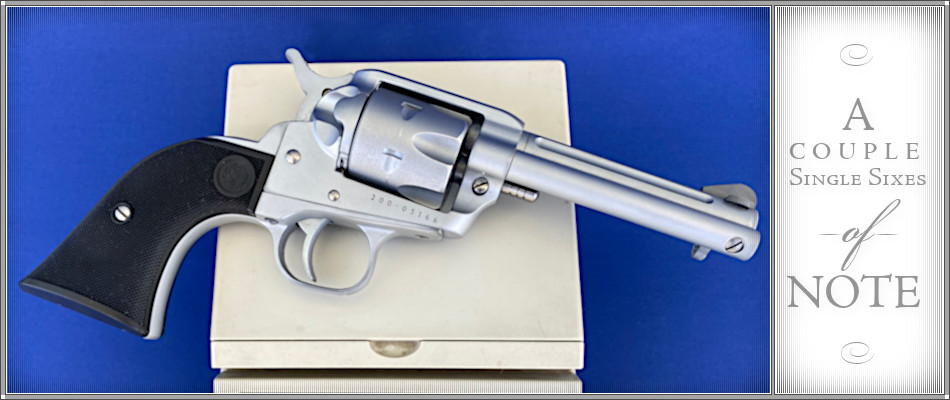
June 2022, A Couple of Single-sixes of Note— Don’t have much time these days to do much in the way of exotic projects but did complete a couple recently that bear mention;

Biggest handicap was weight at 30 ozs. The diet program consisted of the following:
* Standard aluminum grip-frame and ejector housing
* Custom, fluted aluminum cylinder
* 4-in. sleeved (aluminum) barrel w/flutes
* Titanium pins, screws, base pin, mainspring strut and clip, base pin latch


Other primary improvement is with the sights. After the major components were hard-chrome plated, the rear sight notch was blacked; front sight is a dovetail steel part in matte-blue finish. Coupled with .223 chamber throats, the little fellow is startlingly accurate. Grips are factory. Finished weight is 15.9 ounces, almost 50% lighter than stock. Handles like a cheap cap pistol.
The second is a fairly serious effort to produce something akin to the great Colt Flat-Top Target model but on the handsome vintage Single-Six with the dovetailed rear sight set in its especially elegant topstrap. Barrel and front sight are custom pieces as is the rear sight, patterned after the Colt New Service Target model sights. Power Custom supplied their excellent two-piece SAA-style grip frame. Turnbull Manufacturing provided the coloring; bluing and nitering was done in-house. Rob Rowen provided the crowning touch with a set of Colt Flat-Top Target-style, checkered fleur-de-lis grips. Also surprisingly accurate, perhaps owing to the dedicated rim-fire caliber Douglas barrel material.

February 2021, BLUE RUGER .44 MAGNUM REDHAWK W/ANACONDA BARREL— Had a customer who found a blue round-butt Redhawk we built many years ago. Really liked the gun but really wanted an Anaconda barrel on it. A stainless barrel on a blue gun wasn’t an attractive prospect so we cast around for a cosmetic cure. Most stainless bluing we’ve seen isn’t terribly predictable and often doesn’t wear well. Often, it is impossible to produce a true gloss. Old friend Marc Morganti—another great fan of Ruger double-action revolvers—put us onto PVD (Physical Vapor Disposition) coatings which he uses regularly in his custom revolver work. This is a high-tech coating process that applies a super-hard, super thin metal ceramic coating. Available in a variety of colors (including a blue/black), it follow existing polish very well and is super scratch-resistant. Sounded like the solution to the problem and we all signed on. We stripped the original blue and polished gun and barrel to match and had the coating applied. Not entirely sure I would have ever suspected the finished gun to carry anything but ordinary hot-salt bluing. Beyond metal preparation, the finish isn’t hideously expensive though it is probably a last-ditch method to save a job such as this one. We have a Freedom Arms revolver which may well wear this ‘bluing’ in time. Some custom colors are available so, with some luck, we’ll be able to apply ‘nitre blue’ to screws, pins and, perhaps, the trigger. With some of Rob Rowen fancy French walnut grips, ought to make an especially handsome gun very much in the traditional style rather than the cold contemporary predatory-looking stainless. Grips are sheep horn from Rob Rowen. Along with the barrel and finishing, gun received the usual tune, sights and an extra-length firing pin. The front-sight blade is a white-line ramp style to match a white-outline/square-notch rear sight. Feel free to inquire about these finish options.
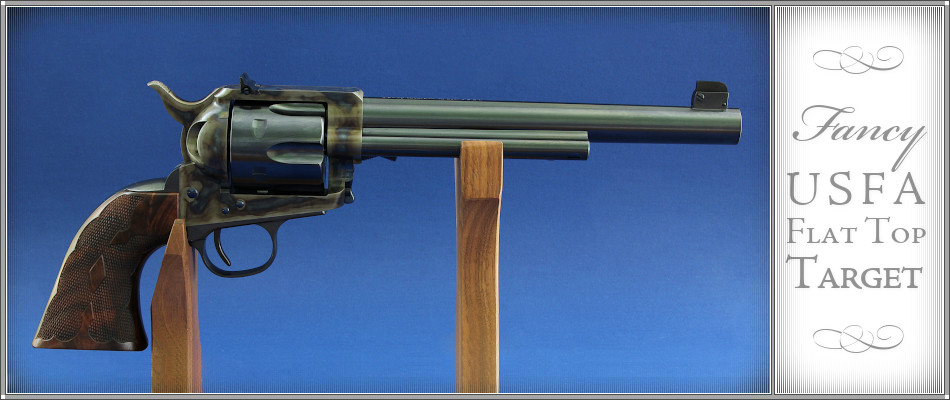
July 2020, Fancy USFA Flat Top Target— Once the Colt New Service double-action revolver arrived on the scene around the turn of the century, Colt probably didn’t produce many more Flat Top Target model single actions. No doubt, part of the appeal of the New Service was the more flexible adjustable sights. Not terribly sophisticated by contemporary standards, front and rear sights shared adjustment duties between them: the rear sight handled only windage, the front only elevation. Still, each was a clever piece of work and very handsome if not especially hardy.
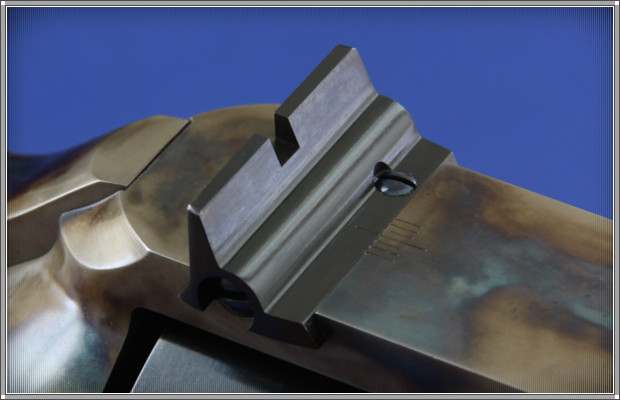

The rear sight is actually more like that found on the Woodsman with the windage adjustment screw in the sight body rather than the receiver. The single action top-strap is not really thick enough to accommodate the loss of cross section and strength the screw hole would cause. On the New Service, the screw is actually in the standing breech behind the top-strap where the section was large enough to safely support it. It is, however, wider and scaled to the larger revolver receiver. Like all the Colt windage-only rear sights, this new design features the usual lock screw to hold the adjustment. The adjustment hash marks are on the top-strap same as the double-action Colts. The front sight on the custom barrel is nothing more than a faithful copy of the original New Service sight, down to the two adjustment hash marks and the lock screw. Sadly, no Colt single-action Target Model is known to sport these sights.
Accordingly, we decided to them is a whirl on one of the fine USFA Flat Top Target models, this example in .32-20. Every effort was made to capture the character of the original Colt Target Model, down to the one-piece factory-style fleur-de-lis grips in fancy French walnut executed flawlessly in his usual inimitable style by Rob Rowen. All the metal work is carefully trued and detailed. While most original guns were all blue, the owner of this preferred coloring which, along with the carbona bluing was performed by Turnbull’s. In addition, the custom pivot and ejector housing screws are all regulated.
We have a couple of .22 projects for the shop at some point—a Old Model drift-adjustable sight model and an M97 Freedom Arms model—that will probably end up sights with this rear sight. It is low and well-integrated and adjustable. Pinned front sight blades are easy to change so, while not the handiest arrangement around for adjustments, it is certainly attractive.
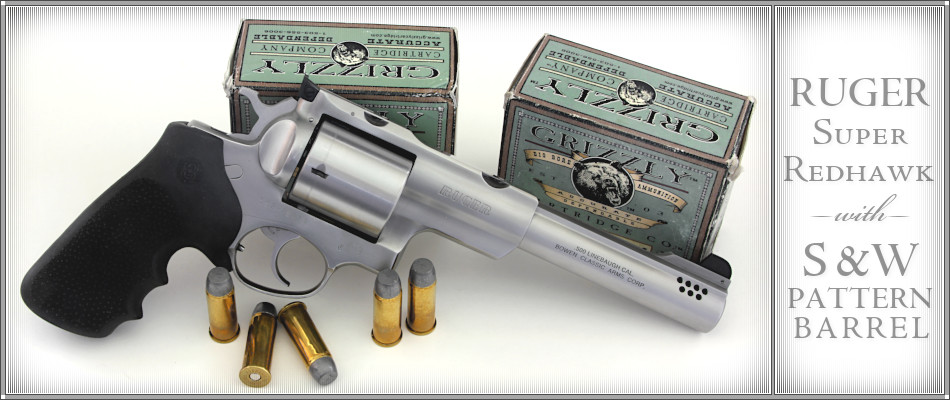
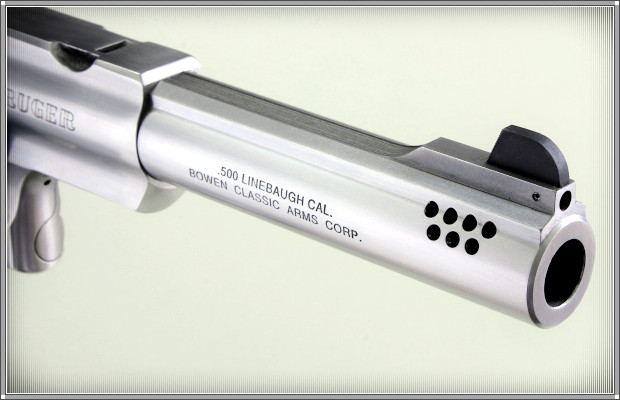
May 2020, RUGER SUPER REDHAWK SMITH & WESSON-Pattern BARREL—While nobody is ever likely to adjudge the Super Redhawk a beautiful revolver, it has potential to be at least handsome. Pondered a number of barrel forms. Since the ejector is shrouded by the receiver extension, most barrels are really nothing more than single-action barrels scaled up to the massive receiver ring. Since S&W barrels mate especially well to Ruger single-action revolvers, seemed eminently sensible to try one on a double-action revolver. Identical to our usual L-frame pattern Redhawk barrels but without the underlug. And, like our L-frame and SP-style barrels, these are necessarily produced from 2-inch diameter barrel blanks. At this writing, our usual supplier of these blanks—PAC-NOR Barreling—is still down due to a devastating fire but we have a fair stock a material at hand for the present. Large as they are in diameter, we have room to machine our integral muzzle brake in the .475 and .500 calibers. We will catalog this barrel as an option to standard Super models and as component of big-bore caliber conversions.
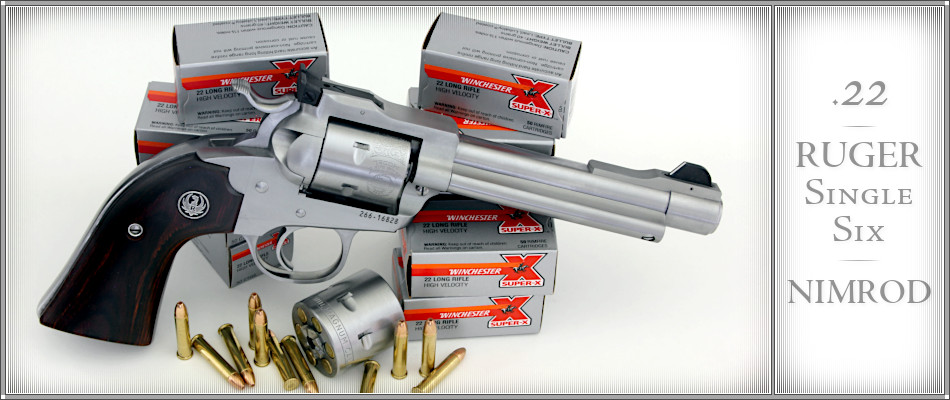
April 2020, RUGER .22 RIMFIRE NIMROD — Had a customer who wanted a .22 Rimfire companion piece to a .500 Linebaugh ‘Nimrod’ pattern revolver we had built for him. Not something we had done in the past, we decided to give it a try and see how it turned out. Scaled down the barrel and sights by the seat of our pants and ended up close enough to capture the character of the larger guns. Like its big-bore brethren, the wee rimfire Nimrod balanced well and handling was still quick and lively. The additional barrel weight practically eliminated what little recoil obtained in both the LR and WMR calibers. While this model was never produced at the factory as a convertible model, loose WMR cylinder are found easily at various parts sources. We will be happy to entertain similar projects in both .22 and .32 calibers.

August 2019, Ruger GP100 with Python Barrel — Along with the recent acquisition of a batch of Colt .45 cal. Anaconda barrels, we also received a few Python barrels. While these do not gracefully mate with S&W revolvers due to the barrel rib and topstrap configuration, as with Anaconda barrels, they are a perfect match to appropriate Ruger products. Fitted one to a standard stainless GP100. With the fast twist rate and comfortable Ruger compact grips, this gun proved to be exceedingly accurate with the excellent Grizzly Cartridge Co. 180 gr. .357 ammo. For a serious, skilled marksman and hunter, this would make an effective medium-game combination. Local deer should be very nervous. Ruger makes both 10MM and .44 Special GPs now so, with re-bored Python barrels kept to close four inches, no reason one couldn’t produce a nice medium-bore with these larger calibers.
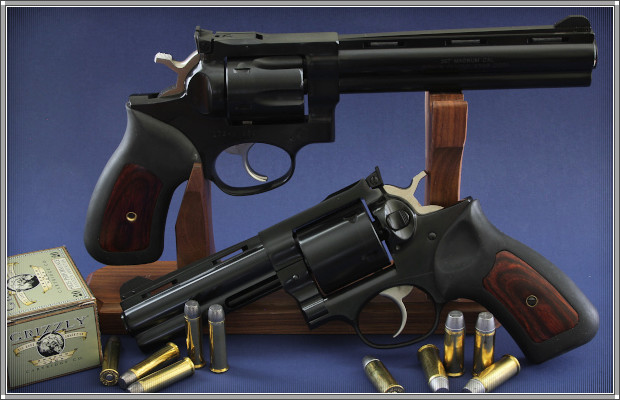 A couple of blue GP's with Python barrels. The top gun is a 6-1/4" .357; to bottom a 4-1/4" .44 Special with a re-bored Python barrel
A couple of blue GP's with Python barrels. The top gun is a 6-1/4" .357; to bottom a 4-1/4" .44 Special with a re-bored Python barrelThe procedure to adapt Python barrels to GP is exactly the same as those to fit Anaconda barrels to Redhawks. Bear in mind, as with Anaconda barrels, barrels will finish out at about 1-3/4 inches less than the starting length. Only 6 and 8-in. length are suited to these conversions; 8-in. barrels will shorten fine to 4-1/4 inches. Only .357s are really suited to a 6-in. barrel due to barrel-shank strength considerations. Sadly, we had very few Python barrels so will not catalog this conversion. However, we can still perform these installations though at a slightly higher cost since NOS or take-off barrels will have a good bit of extra work in gracefully remove the lettering. This particular specimen is also tuned, fitted with a longer firing pin and BCA sights, front and rear. In addition, the cylinder sports a black powder chamfer.

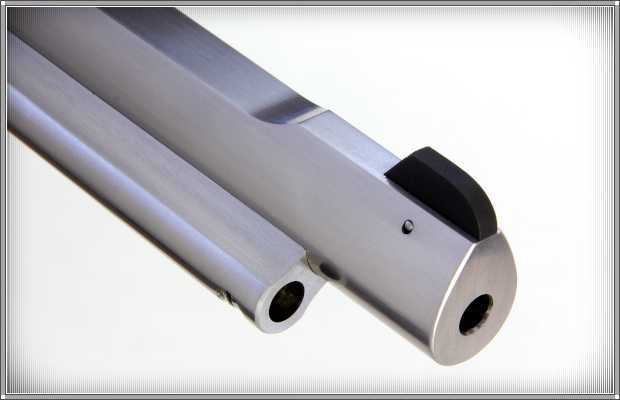
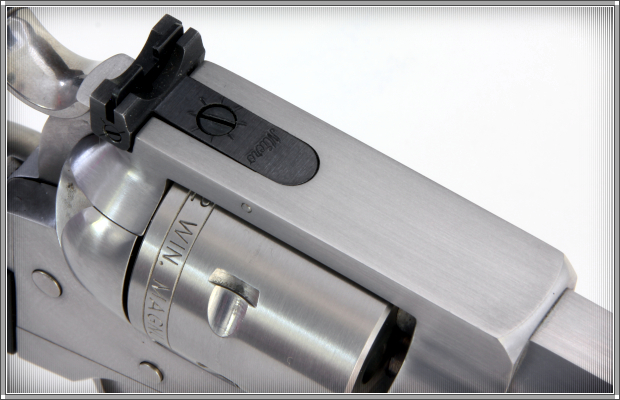
June 2019, Ruger Single Six Flat Top — Recently, a prospective customer queried us about the appearance of an ovate-form barrel on a Ruger Single-Six revolver. Just happened to have a gun featured in the Winter 2017 issue of the Classic Arms Journal answering the description.This little fellow is used mostly in .22 WMR and is of stainless steel befitting a working field gun. Since ovate barrel muzzles are best left clean and tidy to show the sectional profile to best advantage, we did not cut the integral base for the DX-type detachable blade system and rely instead on the cleaner pinned-in blades retained by a dome-headed pin. This particular barrel is 5-1/2 inches, a handy all-around length comfortable to carry and with sighting radius enough to give a good account of itself in the field. In addition to the barrel, gun is tuned and fitted with a Bisley-spur hammer and an oversize locking base pin. The original XR3-RED grip frame was replaced in favor of the smaller XR3 Colt SAA-size part and a set of the 50th Anniversary Flat Top hard-rubber grips installed. The other important feature is the Flat Top-style top strap. Not sure why Ruger never produced their wonderful small-frame single actions in the classic receiver style but that is nothing a little welding, polishing and milling won’t fix.

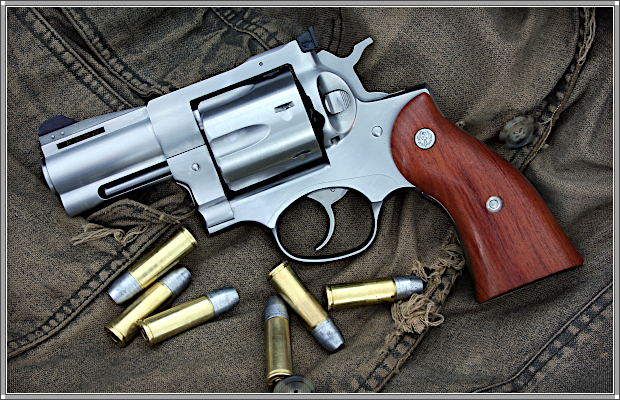
December 2018, ANACONDA BARREL INSTALLATIONS ON .45 and .454 REDHAWKS—We have secured a fair quantity of unpolished 6-inch .45 Colt Anaconda barrels as well as a small number of .44 caliber barrels of 6 and 8-inch length. These are quite difficult parts to find these days and are much-sought for installations on Ruger Redhawks. The result is finished and sophisticated and far less costly than custom L-frame or SP-style barrels laboriously carved from from 2-in. diameter barrel blanks. Accordingly, we will offer Anaconda barrel installations with our barrels as regular catalog items as long as the supply lasts. We have mostly 6-in. parts but can offer these installations on two lengths: 2-3/4 inch(actual is quite close to 3)and the usual 4-1/4 inch. Twist rate is 1-16 which will stabilize even the heavy 405 gr. bullets in the Garrett .45 RHO (Redhawk Only) load.
The conversion also results in a slightly heavier gun but the shorter barrel keeps the weight close to your hands for more lively handling. Recoil with the potent Garrett .45 RHO loads is snappy but less bothersome than in the stock 4-in. Redhawk. These barrels also work very well on our GP44 Redhawk, a modified Super Redhawk Alaskan, which affords even better recoil control through friendlier grips.
These conversions will be available as an option to most of our Redhawk packages. We will be happy to offer these as a retro-fit to Redhawks with our cat. no. RD01 ‘Standard Issue’pkg. already performed. Please see the website catalog for further details or contact us with your questions.
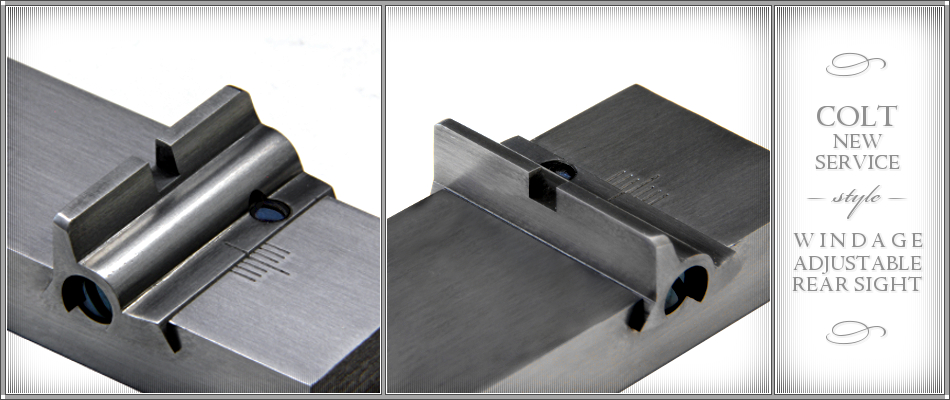
August 2018, COLT NEW SERVICE STYLE WINDAGE ADJUSTABLE REAR SIGHT— Unlike Smith & Wesson who produced a target-model adjustable rear sight with provision for both windage and elevation movements, Colt’s initial foray into modern adjustable target-style sights started with sights with only one axis of adjustment: windage in rear sights and elevation in front sights. Effective enough and served Colt well from around the turn of the last century until World War Two.
Colt made the rear sight in two basic designs. Both featured un-detented movement with a screw with a lock screw in the body to set the adjustments in place. The windage screw was stationary with the body moving in a dovetail slot. New Service models, with their thick, heavy receivers and topstraps sported the adjustment screw in the topstrap itself with the screw head and the internal groove engaging corresponding notches in the body for the movement. This same pattern was utilized in all the pre-war double-action revolvers and single-shot Camp Perry Model. The Woodsman .22s, however, had the screw in the sight body itself to keep it clear of the slide’s internal bits. This general pattern of sight was introduced after the heyday of the single-actions and has not been found on them to our knowledge. These models all had hard-set dovetail rear sights adjustable only with a hammer and punch.
Both SAA and Bisley Flat Top Targets are, however, susceptible to screw-adjustable dovetail sights as are USFA Flat Tops, Ruger Single-Sixes with dovetail sights and any of a number of other revolvers that can attractively accommodate dovetail rear sights. Problem is, these guns typically have relatively thin topstraps with the dovetail cuts away from the receiver itself. Placing the adjustment screw in the topstrap proper would weaken it a good deal. Accordingly, these guns need sights with the adjustment screw within the body. Alas, no such sight exists in nature. The Woodsman sights are both rare and costly when found but more especially they are too short for the typical revolver top straps which are about .700 wide. We have several projects to do—a couple of USFA Flat Top Targets and a Ruger Single-Six and, perhaps, a welded-up Ruger Flat Top—where a dedicated sight variant of this general design would be a nice addition. Hope to have them in hand in due course. The photos are of the test mule which should make for an especially handsome installation on appropriate guns.

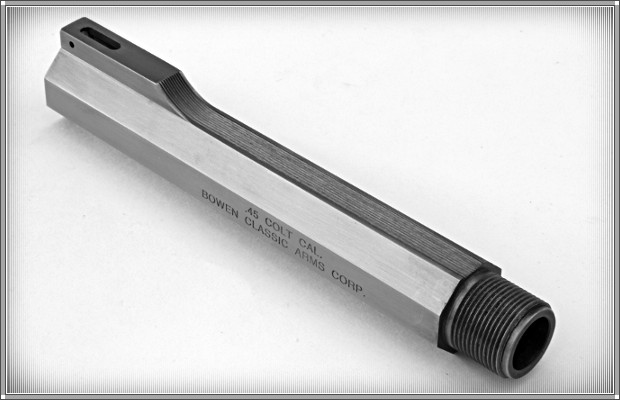
July 2018, Grooved Octagonal Barrels— Octagonal barrels remain a perennial favorite on contemporary custom single-action revolvers. Our barrels have traditionally featured not only integral recoil lugs but integral front sight bases as well. Bearing in mind that Winchester and many of the British rifles of the day featured rolled or file-cut matting on barrel flats, it occurred to us we should try some octagonal barrels with groove top flats to provide the same effect on revolvers. The cutter used to cut the sweep up on the rear end of the front sight base is the same one used for bases on our custom L-frame and SP-style Redhawk double-action and the ovate and S&W-style single-action barrels. Our grooving cutter matches the sweep cutter radius so grooving the sweep up to the base flat is a simple matter. While we do not ordinarily groove the SP and ovate barrel, all the ribs on L-frame and conventional S&W barrels are cut for the usual grooves. The grooves are more typical to revolver barrel ribs so are what we would offer now.
In any event, upon request we are prepared to add grooves to the top flat of our octagonal barrels on request at modest additional cost. The 5-shot Bisley shown here received the treatment. The coloring is from Turnbull and the mastodon ivory grips (with papers/provenance) are from Rob Rowen.
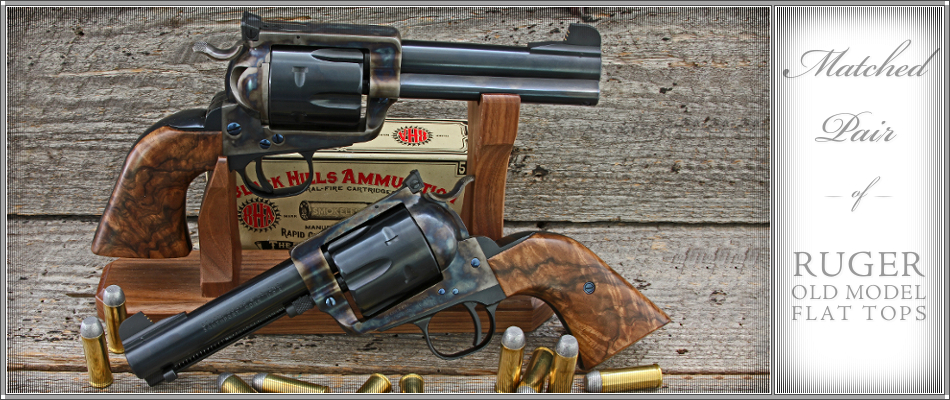
June 2018, Matched pair of fancy .45 Flat Tops —There isn’t much about this pair of Old Model large-frame Flat Tops that is especially sophisticated or remarkable. Still, this is a gun Ruger should have made and, in light of the enduring popularity of short-barreled .45s, we still turn out a few from time to time. This matched pair, commissioned by an admirer of these grand old guns, may be a simple enough effort but the result is all out of proportion to it. Hard to imagine a more restrained and elegant but ever-so-useful vintage-style single-action revolver. These started life as beaters of little interest to collectors. Back in the day, a lot of .44 Mag. Flat Tops went from the factory shipping box directly to work in the field and never looked back. They were tough guns and, even with much finish ands some original parts gone, they were still in fine mechanical condition and just the thing for this project. It really didn’t take much.
In an effort to get the best possible finish quality, the original aluminum XR3 grip frames were replaced with modern steel parts, made possible by the excellent David Clements hybrid trigger which has Old Model sear surfaces and New Model return-spring seats. These mated well with the Power Custom Bisley-spur hammers on hand; guns were tuned in the usual way.
The change to .45 Colt was simple: the original cylinders were re-chambered with a small-body, small-throat reamer for best performance. The barrels were nothing more than take-off New Model Bisley barrels, shortened, re-tapered and remarked in the factory style. To keep the base pin under control, the guns were fitted with an oversize locking pin which also made carry-up timing a little easier to set precisely. The receivers were remarked as to caliber. Other than sight regulation, everything else was largely cosmetic.
Cosmetics, or not, these are using guns and the owner wanted sights he could see so we installed a heavy-duty rear target-style sight on each. For improved appearance, we used our house custom front sight and then pinned in a Keith-style three gold-bar Patridge blade. The only other touch in form is the black powder cylinder chamfer.
As always, the crowning act was the matched set of fancy French walnut grips from Rob Rowen. The blanks were careful chosen and are very close in character. Fit and finish is impeccable. The grip frames were decked and trued to give Rob the best possible platform for his handiwork. Turnbull Manufacturing supplied the wonderful coloring; the shop did the hand polishing, hot-salt blue and nitred the screws.
These old troopers get a new lease on life with just a little work and will carry on for a few more generations . Simple. Beautiful. Useful. Doesn’t get much better than that.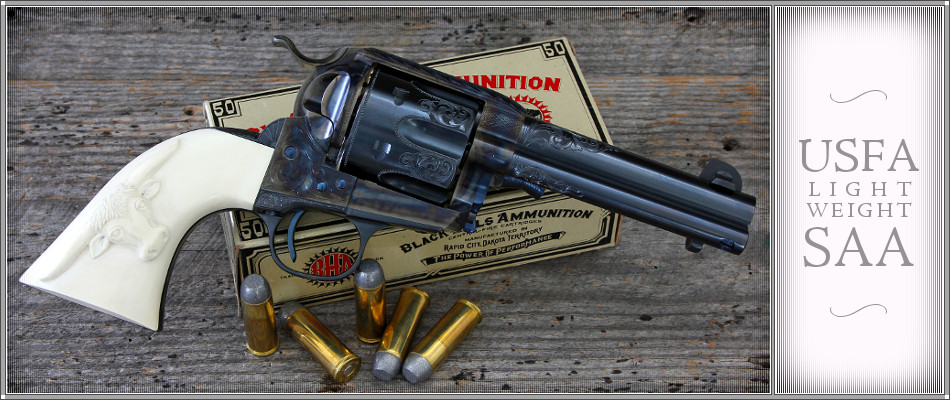
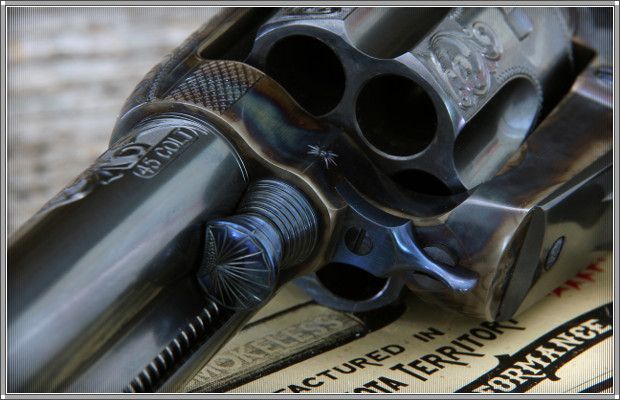

Happily, those of us who ply the custom revolver trade still have the occasional client who was born in the wrong century and wishes to be armed properly. One such chap commissioned a fancy light weight USFA (United States Fire Arms) SAA in the style our Texan friends refer to as a ‘bar-b-cue gun’ where a rather dressier piece is indicated for cookouts and evening events. This particular gun started life as a standard USFA SAA model in .45 Colt. The barrel was shortened to 4 inches and fitted with a pinned-blade dovetail sight typical of the factory Colt sheriff’s models of the 1880s. The ejector was retained in the interests of easy reloading. Whether the effort of lightening the gun is really worth it is another question but the narrowed receiver rails and scallops recoil shield and loading gate to lend an air of purpose to the gun it might not have had otherwise. Same for the Bisley hammer which which affords much quicker cocking for follow-up shots with on,e and especially, two hands. The most unique feature is the base-pin lever retaining latch borrow from the Keith No. 5 Colt which positively locks the base pin in place, unlike the standard spring-loaded plunger arrangement which is known to fail now and again. The groove, hour-glass shaped, over-sized base pin makes removal easier in cold weather or when the gun needs a good cleaning. Tuning the action completes the mechanical work.
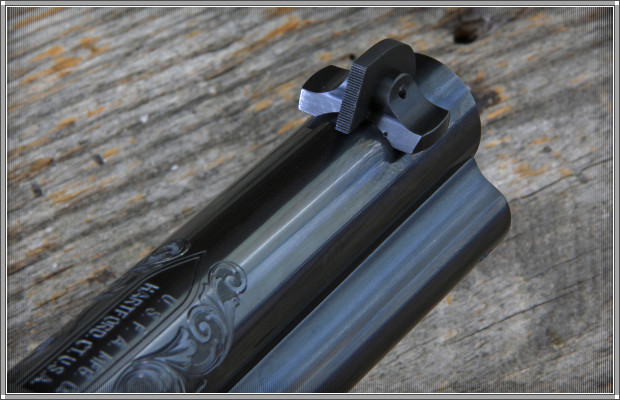
The gun arrived here with a set of classic one-piece steer-head ivory grips from Nutmeg Sports. Once all the metal work, shaping, fabricating and polishing was done, the gun traveled to the studios of Brian Powley for engraving. The gracefully executed partial-coverage engraving pattern does not overpower but rather accentuates the classic lines of one of the greatest revolvers of all times. Turnbull Manufacturing provided the carbona blue and color case. Nitered screws complete the detailing. These short-barrels Colts first saw the light of day over a hundred and thirty years ago and remain just as stylish now as then. They are a house favorite at Bowen Classic Arms to this day.
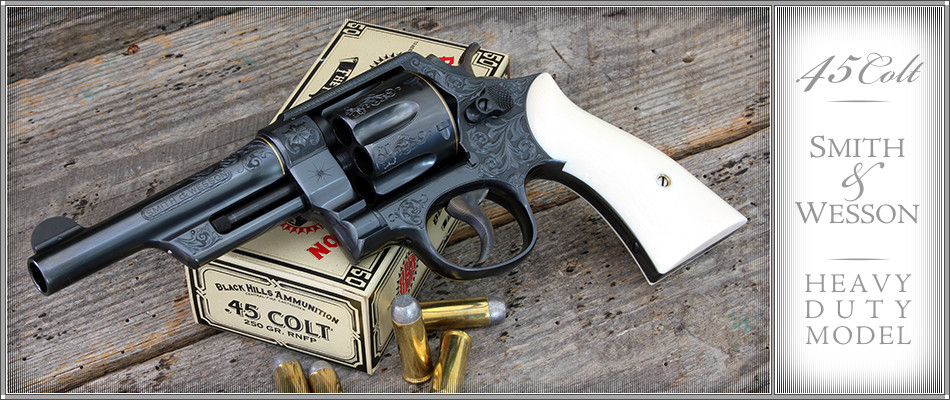
April 2016, FANCY SMITH & WESSON .45 COLT HEAVY-DUTY MODEL — Thanks to the especially handsome engraving from Brian Powley and the beautiful ivory grips from Paul Persinger, this overhauled Smith & Wesson is a cut above the usual. Completely rebuilt mechanically, it is also converted to .45 Colt. A taller front sight blade is pinned in for proper sight regulation. In keeping with the retro styling, the cylinder has the traditional black powder chamfer. The gun is completely hand finished and detailed; Turnbull Manufacturing applied their carbona blue and re-colorcased the hammer and trigger. Certainly, the whole is greater than the sum of the parts.

March 2016, RUGER REDHAWK WITH 4-IN. SP-STYLE BARREL — This is a relatively stock .45 Colt Redhawk with tune and sight work but with the addition of a custom 4-in. SP-style barrel we have not heretofore installed on a Redhawk. This barrel profile is lifted from Ruger’s own SP101 series of small-frame revolvers and makes for an imposing gun applied to the large-frame Redhawk.
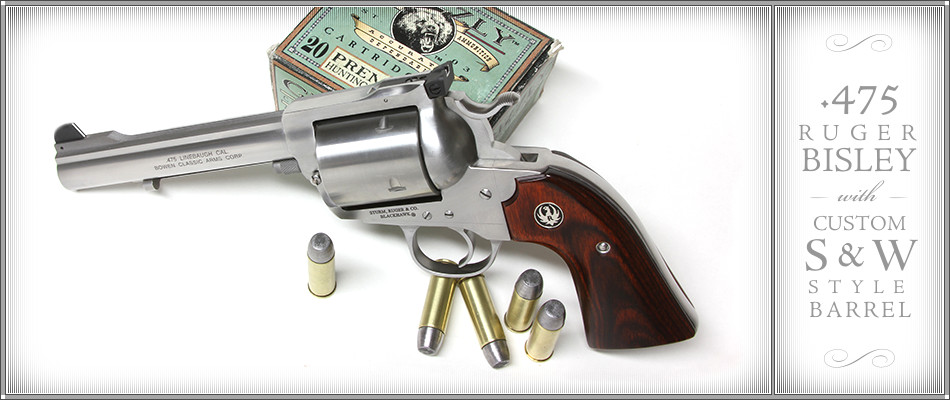
January 2016, .475 Linebaugh Ruger Bisley with Custom S&W-style barrel — We have installed any of a number of Smith & Wesson barrels on Ruger single-action revolvers over the years in calibers from .22 Long Rifle to .500 Linebaugh. Most were simply modified K or N-frame parts and used in the existing calibers. However, some, especially the .327 Single-Six barrels and any .475 or .500 Linebaugh barrels were re-bored from smaller calibers. While we have a new source for re-boring handgun barrels now, the largest available re-bore is to .45 caliber. With the passing of friend and colleague Jim Dubell we lost our only source for re-bored S&W and Redhawk barrels in .475 and the .50 calibers. Luckily, not all is lost.
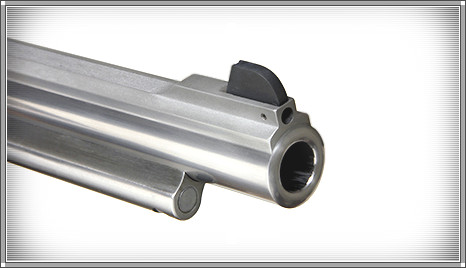 Barrels feature the DX hand-detachable sight-blade.
Barrels feature the DX hand-detachable sight-blade.We will continue to offer S&W barrel conversions on Ruger single-action revolvers using factory barrels where we can. However, in the case of the .475 and .500 calibers where re-boring is no longer an option, we will simply make the barrels from scratch. Smith & Wesson N-frame target barrels are not tapered much so, in the interests of simplicity and the extra margin of holding power the thicker walls of an un-tapered barrel afford the ejector housing screw, all of our custom S&W-style barrels will be in that form. In all other respects, these barrels will very closely resemble factory parts, down to the intergral front sight base and grooved rib. While we can also offer pinned-in blades, the DX-style sight blade arrangement is standard in the interests of flexibility. We’ll be able to produce these in standard length from around 3-1/2 inches to 7-1/2 inches.
Costs will vary from gun to gun since the top straps with a heavy bevel at the muzzle end will have to be welded up and re-contoured to insure there is no gap behind the barrel rib. Even with careful matching of filler rod material and drawing back of the receiver to bring weld hardness back to that of the receiver, there is always a possibility of shadows in the bluing. Same is true even of laser welding which is our usual choice of process . Accordingly, we recommend the receiver be color cased, to eliminate the potential from bluing problems.
Along with octagonal and ovate barrel forms, round, ribbed barrels are a stylish and elegant addition to a custom single-action revolver.
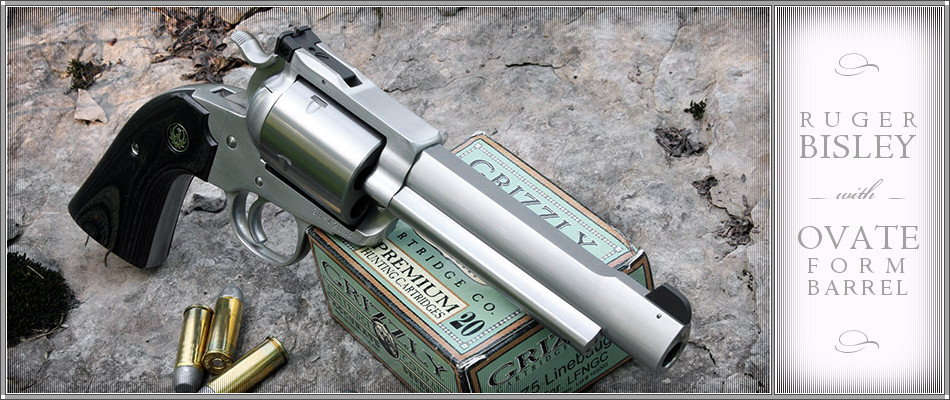
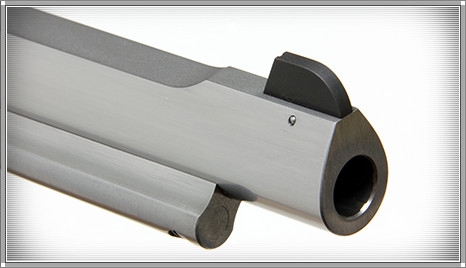 Custom Ovate-Form Barrel with Pin-in front sight
Custom Ovate-Form Barrel with Pin-in front sight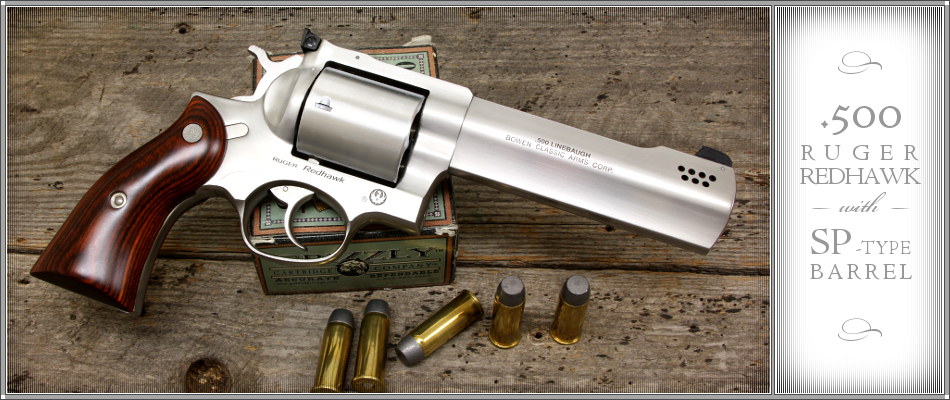
August 2014, Ruger Redhawk with SP-style Barrel — The Ruger Redhawk is arguably the best heavy-duty, big-bore revolver ever devised. While not as pretty as the most refined and delicate S&W, it is still a handsome brute. Perhaps its greatest asset is its flexibility. Few other big-bore revolvers are suited to so many different calibers and barrel styles.
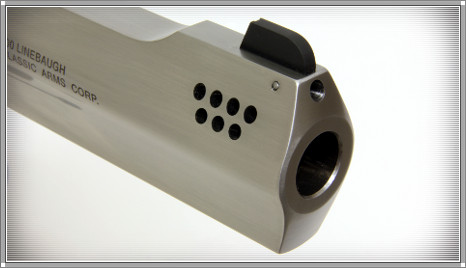 Custom SP-style Barrel with internal compensator
Custom SP-style Barrel with internal compensatorWe’ve built these with shortened factory barrels and barrels from Dan Wesson and Colt Anacondas. The enduring favorite is our custom L-frame style full-underlug barrel scaled to the larger Redhawk. With the introduction of the SP101 pocket revolver, Ruger produced an especially handsome variation on the L-frame theme with its unique barrel form. A sort of an ovate barrel with a full-length but underlug but of more conventional form, similar to the half lugs found on standard Redhawks and GP100 or similar Smith & Wesson models. It was an obvious style for the Redhawk and brings to both the standard and modified Super Redhawk Alaskan models a distinctive heavy barrel with Ruger’s distinctive style. This particular gun, chambered in the great .500 Linebaugh, sports a 5 1/2 inch version of the barrel with our integral muzzle brake.
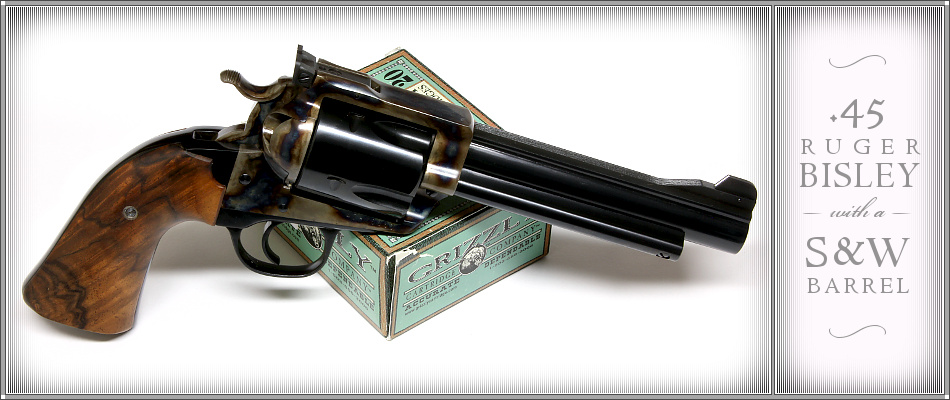
January 2013, Ruger Bisley with S&W Barrel — This Ruger 5-shot .45 Bisley is fitted with a modified Smith & Wesson M1955 Target barrel. Finished at 5-1/2 inches, it is as subtle and graceful a barrel installation as imaginable. Of very high quality, these barrels typically shoot extremely well. The last test group (5-shot) fired off-hand at 25 yds. after final assembly landed in about 1-1/2 in. (far better than average day at the range for the shooter, to be fair), using our house 5-shot load with a Forkin-cast 350 gr. LBT LFN bullet with a .500 nose booming along at 1400—1500 fps. The white-line front sight blade is pinned to the base for easy removal. In addition to the barrel and a steel ejector housing, the cylinder is fluted and chamfered and the receiver, gate and hammer colored by Turnbull Manufacturing. Roy Fishpaw provided a set of his magnificent french walnut grips. Smith & Wesson barreled Ruger single actions are a house favorite at Bowen Classic Arms. We’ve built them in both blue and stainless in every caliber imaginable from .22 (on a Single-Six) to .500 Linebaugh Bisley models and about everything in between.
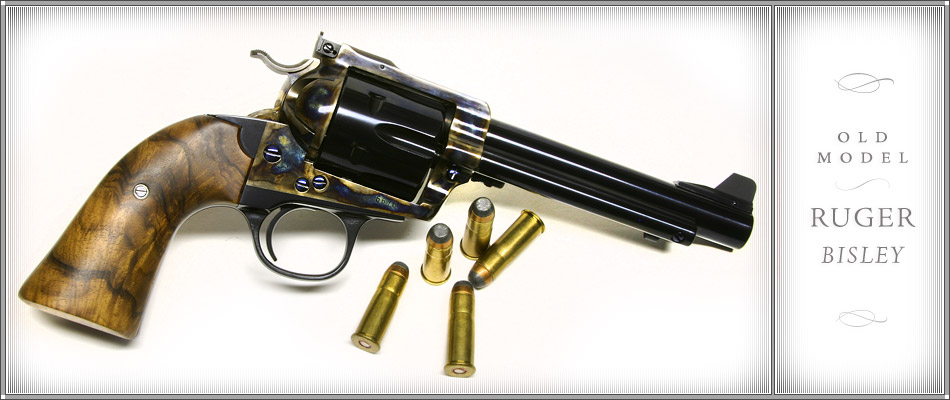
August 2012, Old Model Ruger Bisley — Since the newest generation of single-action shooters largely cut their teeth on Ruger Blackhawks and Vaqueros, all the arm-waving and foot-stamping about the New Model Ruger lockwork by purists may not make a lot of sense to the newbies who acclimated perfectly well to available Ruger revolvers. The newest iteration with the indexing pawl arrangement has done a lot to diffuse the legitimate complaint that the chambers and loading trough did not align properly for easy loading and unloading. Even so, the new guns just don't sound or feel the same to True Believers. Further, many of the later Ruger models--such as the Bisley--were never offered in Old Model persuasion. Neither were the early XR3 Colt-style grip frames available in steel. Nobody was going to get the best of both worlds without intervention. Happily, there is always some meddlesome sort who not only sees clearly what needs to be done but can do it. Thanks to both David Clements of Clements Custom Guns and the fine folks at Power Custom, we have an assortment Old Model hammers and triggers that enable the custom trade to produce heretofore unavailable Old Model Rugers.

Hybrid Trigger and Old Model Bisley-spur hammer from Dave Clements
With the advent of their Keith No. 5 two-piece grip frame sets for both Old and New Model Rugers, Power Custom produced both a Bisley hammer and a standard wide trigger with Old Model lockwork and sear surfaces. While David Clements has produced both true Old Model Bisley and Bisley-spur Army-style hammers and standard and Bisley triggers, perhaps his most intriguing and useful parts are the hybrid Old Model Bisley and standard triggers that feature standard Old Model lock sears but are designed to use with the New Model trigger return spring arrangement common to the various New Model grip frames. What this means, in the giant scheme of things, is we can build Old Model guns fitted with any New Model grip frame. The gun shown here is a good example. It started life as an ordinary .41 Magnum Old Model Blackhawk of no partuclar distinction. An unfinished chromoly Bisley grip frame from Ruger bolted right up without drama and integrated as well as on any New Model with just a little careful filing and shaping. Clements hybrid Bisley trigger fitted and worked perfectly with no modifications beyond basic tuning. Used in conjunction with the companion hammer, you can't tell if from a typical Old Model action with your eyes closed. The orignal cylinder was rechambered to the .44-40 cartridge and a new barrel fabricated. In keeping with the retro theme, Turnbull provided the color case. The cylinder received the traditional black powder cylinder chamfer and the screws were nitre blued. Coupled with a set of magnificent French walnut grips from Roy Fishpaw, it is a Twentieth Centurey Ruger even a Nineteeth Century Colt nut could love.
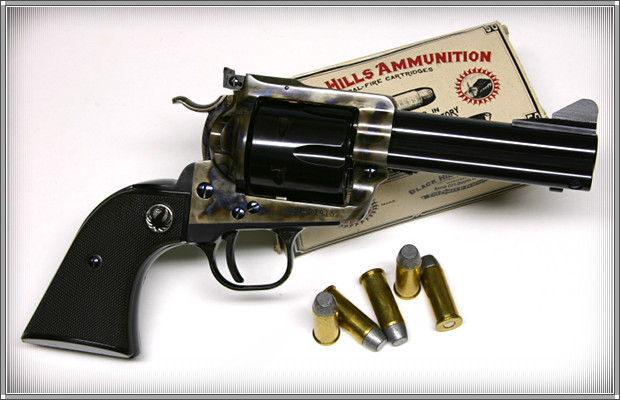 Old Model Ruger .44 Special with steel XR3 grip frame
Old Model Ruger .44 Special with steel XR3 grip frameAnother favorite gun we can improve upon is the Old Model Blackhawk. While the later XR3-RED grip frame is not the knuckle banger the original XR3 grip frame is under heavy recoil, many shooters still prefer the slightly smaller grip frame so reminiscent of the Colt SAA. On the other hand, few shooters except serious outdoorsmen for whom weight is a real concern, have ever warmed to Ruger's aluminum grip frames, even the desirable XR3 Old Model parts.With the advent of the New Model Flat Tops and New Vaqueros, we now have the Holy Grail of grip frames in the form of a steel XR3 part. Alas, it is not compatible with the Old Model lockwork until now, thanks to the standard Clements hybrid Blackhawk trigger. It is a simple matter now to produce a very finely finished and detailed Old Model Blackhawk; producing, in essence, a Colt New Frontier of better mechanical design.

December 2011, Custom Freedom Arms .327/.32-20 — From the start of our foray into the M1997 Freedom Arms revolvers, we contemplated not only a fixed sight version but also an adjustable-sight variant based on the pre-war Smith & Wesson sights found on their various target models. The pre-war S&W revolvers are arguable the most beautiful and well made ever produced in the United States. The design was sleek and had many integral features that bespoke great quality and attention to detail. The contoured round barrels, with their integral front sight bases and front bolt bosses, flowed beautiful into a handsome receiver ring with a radius that flowed on into a lovely round-shouldered top strap. Any tinkering with such elegant lines must be done carefully to preserve them as far as possible. S&W’s target sight came as close as anything could have and still been effective. The installation was nothing more than a modified M&P or Hand Ejector top strap will a longitudinal slot milled for the tang which served as the elevator spring and a small cross cut at the back of the strap to accommodate the windage adjustments for the sight blade proper. The seamless fit of the sight tang did not detract from the lines and fairly screamed of quality and craftsmanship.
These early sights were small and did not have the click adjustments of later, more sophisticated adjustable sights but they worked perfectly well and never since have more beautiful and well-integrated sights been offer on factory revolvers. If they had any disadvantage, it was in limited movements which meant merely that most attention must be paid to the front sight height and barrel clocking. Slobs without proper screwdrivers could also disfigure the tiny adjustment screws. While they are not as robust or easy to manage as the more robust factory sights, they are never-the-less, entirely adequate to the job of most revolvers. One must bear in mind these sights were devised purely for target use, not hunting. The fixed sights of the day were designed for hard use in service or police work, in a time when handgun craft was not nearly so sophisticated and developed as it is now. Serious hunting with revolvers was still generations away.
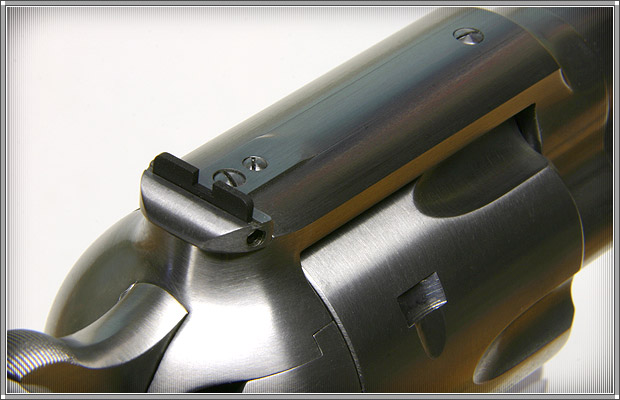

Since the sighting features of Freedom Arms revolvers fixed-sight top straps are very similar to fixed-sight Smith & Wessons, it was not stretch to produce a similar top strap with adjustable sights. We use a proprietary design made especially for this application by David Clements of Clements Custom Guns. Any such sight installation had to be set close to the rear of the top strap which is rounded and would show considerable blade holder overhand. The original S&W pre-war factory sights and Clements reproductions do not quite lend themselves to an attractive installation so some small adjustments in the blade-holder portion of the sight were necessary to achieve a proper appearance. It is important to recognize that, even so, there was a small amount of welding necessary on our prototype to fill in slightly at the face of the existing sight slot so this conversion will be available only on specially ordered guns from Freedom Arms which will be adjustable-sight models without the sight machine work done. More information is available at the website catalog in the Freedom Arms section.
As with our fixed-sight Model 1997s, the adjustable-sight version will feature a new barrel with a pinned-blade front sight rather than the dovetail pattern found on the fixed-sight gun. Ordered with a serial number placed on the bottom of the receiver, this model will be available with all the usual options, including the narrowed frame rails.
While not necessarily the ideal choice for field use, our adjustable-sight M1997 is still a fine all-around revolver with an uncommon touch of pre-war elegance.
October 2011, Comtemporary Colts —With the exception of the Colt Single Action Army and the stray custom New Service project, we do not have much occasion to work on Colt revolvers, especially more contemporary pieces. However, a couple of recently undertaken jobs are worth noting. While these are nothing earth-shattering, they do show very well how a few small touches around the edges of relatively ordinary guns can add a great deal of panache.
One of our customers, a real .32-20 junky and Colt aficionado, wanted a useful field gun which required adjustable sights. Some years ago, he had procured a couple of the limited run of .32-20 SAAs, one of which we cannibalized for the cylinder. Supplied with a .45 Colt New Frontier that was an indifferent shooter (thanks to .457 cylinder throats), we fitted the cylinder and installed a custom 5 ½ in. barrel using our house custom front sight for a crisper sight picture. In addition, we installed an Elliasson rear sight, tuned and sighted the gun.
For reasons known only to the Colt marketing department, New Frontier revolvers have traditionally been fitted with wood grips of the most unattractive wood possible. This gun was rescued with a set of original Colt hard rubber grips which are always of the very best quality and look especially nice against color hardening. The gun was recolored and the screws and trigger nitred. Turnbull’s supplied vintage rollmarks to the barrel for both address and caliber impressions.
The end result is a subdued, modestly modified gun that is far more appealing than the originals. Devilishly accurate, it is hard to imagine a nicer companion piece for idling around in the field.
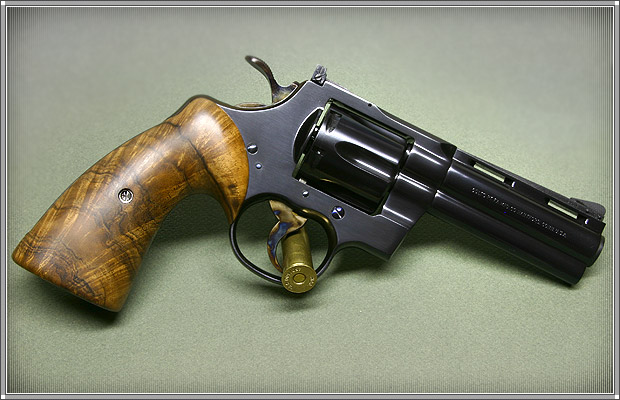 Custom Colt Python
Custom Colt PythonWhile we do not offer commercial refinishing per se, a close friend in the trade came to us with a sadly neglected Colt Python and licensed us to rehabilitate it as we saw best. Pythons pose two problems to mortal pistolsmiths: they have a super hi-gloss bluing which is impossible to duplicate by hand (which left us out) and a mechanical action design that is a Gordian knot of subtle complexity for the uninitiated (like us). Mercifully, this project called for a subdued, satin-gloss finish and required no remedial mechanical work.
First order of the business was to hand polish and burnish the exterior metal work, removing the scattered pitting and stray dings and nicks. The factory had not done an especially good job with the rollmarks so the barrel and sideplate were touched up by engraver Dan Love. He also applied a simple family name on the buttstrap.
We refitted some of the pivot pins so they could, along with all the screws and pins, be nitre blued. The hammer and trigger were color cased by Turnbulls. The crowning act is a set of fancy French walnut grips by Roy Fishpaw. As with the New Frontier, these simple modifications added up to a unique piece, possessed of much more grace and style than the garish factory version with its homely oversized target grips.
MARCH 2011, CUSTOM FREEDOM ARMS .44 SPECIAL — We have for some time wanted to tinker with a Freedom Arms revolver, thinking it would be nice to start with a gun that required no blacksmithing and simply let us pursue the few modifications of style that we fancied. The M97 medium-frame gun seemed a perfect canvas for the project.
While the standard grip frame is fine for the heavy recoil of the .454, .475 and .500WE cartridges, it is a bit large and awkward for lesser rounds, especially in the dainty M97 receiver. This example is modified to approximately Colt SAA grip frame size. Since it is now in two-piece instead of one-piece configuration, Paul Persinger could fit a set of his wondrous one-piece ivory grips. The gun is now smaller with much livelier handling.
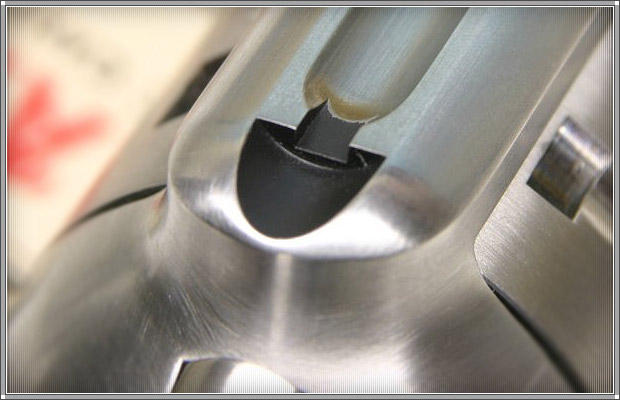
The CeraKoted rear sight notch is a simple and elegant solution to the low-viz stainless fixed-sight problem.
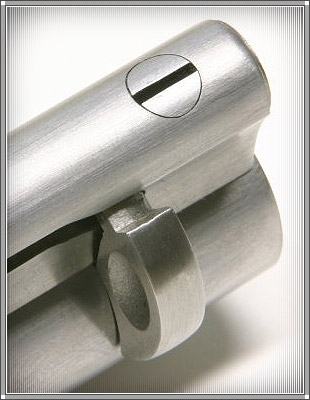

Ejector tube screws & holes are unsightly. This blended, regulated screw is a small touch but dramatically improves the look of the ejector housing installation. Nitre blued pins, screws and small parts always add an elegant touch to fine firearms. Custom chromoly parts replace the factory stainless parts which will not blue.
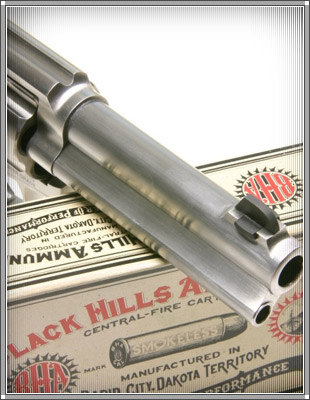
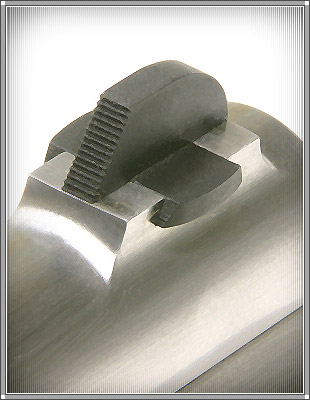
The M&P top strap and integral front sight base are right at home on single-action revolvers. Dovetailed front sight blade is both visible and windage adjustable.
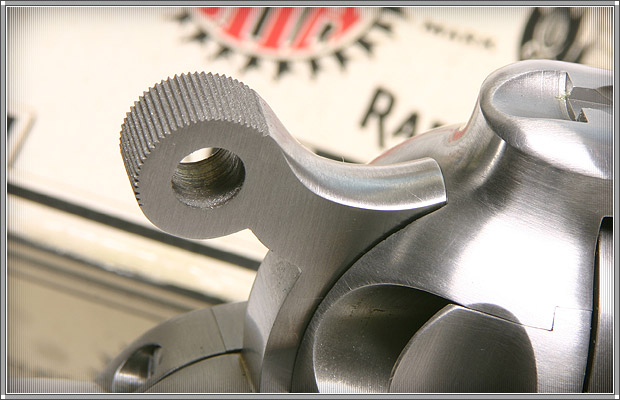
The distinctive ‘commander’ style hammer is not only unique but the much lower spur allows for much faster cycling.
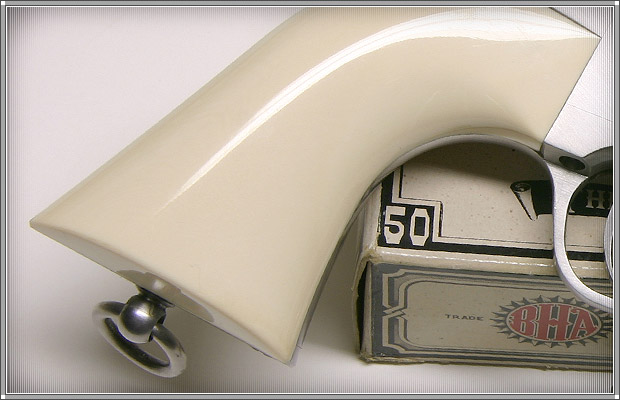
The grip frame is two-piece and very similar in form to the Colt SAA. Paul Persinger made the lovely one-piece ivory grips.
Over the years, we have built a number of single-action revolvers with the S&W M&P style top strap, perhaps the most handsome way to render one with fixed sights. Its charms are no less on the Freedom Arms revolvers. In this case, we simply used the factory sight and sight slot as it came to us but scalloped the receiver ring and recontoured the shoulders. The perennial sighting problem with stainless fixed-sight receivers is the white sights, often near invisible and difficult to use. This problem is solved here with the simple expedient of a local application of CeraKote to the rear sight. This is a mil-spec coating that is exceedingly tough and wear resistant and will give a long life in the protected recesses of the rear sight.
A handsome top strap deserves a handsome barrel so we fabricated and fitted one with an integral front sight base with drift-adjustable, dovetailed serrated-ramp blade. Coupled with the black rear sight, this is a fixed-sight stainless gun with surprisingly good sights. The custom ejector tube screw is regulated and blended with the tube contours for best appearance. Speaking of screws, we fabricated a complete set of chromoly screws and pins for the gun so that we could nitre blue them, adding a nice touch.
Among the more interesting modification available for single-action revolvers are the lightening cuts popularized in the 1930s on vintage custom guns. The kindly folks at Freedom Arms consented to produce this gun with a serial number on the bottom of the receiver, forward of the trigger guard, which enabled us not only to scallop the recoil shield and loading gate but narrow the frame rails, as well. In keeping with the retro styling, we applied the traditional black powder cylinder chamfer to the factory-fluted cylinder. A lanyard ring graces this particular gun.
One of the best ways to make a single-action revolver run faster is with a low-spur hammer of some sort or other. Ruger and Colt single-action revolvers lend themselves to a variety of hammer styles. Gunsmiths have offered Colt single-actions with Bisley-spur hammers for decades. Ruger’s Bisley hammer is readily modified to fit Blackhawks and Vaqueros. Unfortunately, the Freedom Arms receivers and hammers are not configured to permit terribly attractive wide-spur hammers. The hammer wells just sort of run out into thin air and are way short of the top of the receiver. Our solution to the problem of low-spur hammers is simple and unique. Taking a page from M1911 Colt and Browning P35 auto-loading pistol designs, we adapted a ‘commander’ style spur which is a good bit lower for faster cocking and cycling.
We may also offer some combination of them on the large-frame guns though recoil will probably limit the appeal of the smaller grip frame. We have no plans to offer these modifications a la carte. Feel free to get in touch with any questions.
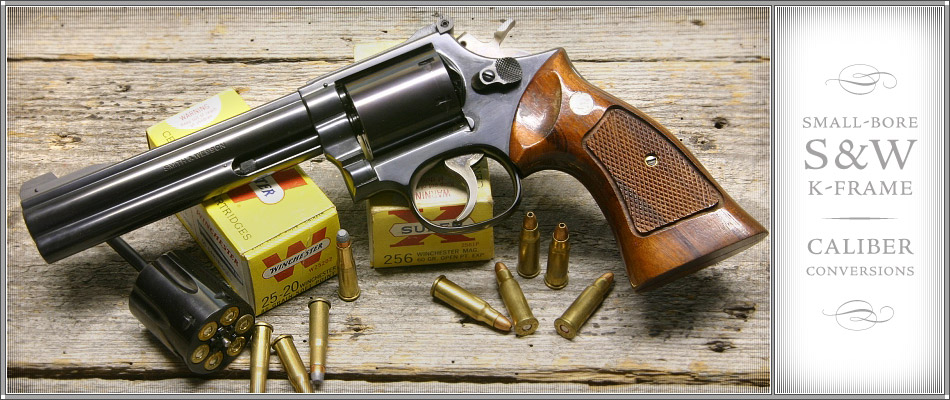
August 2010, Small-Bore S&W K-frame Caliber Conversions — We are happy to report we now have our own long-body, magnum-length K-frame 6-shot cylinders. With these, we can house cartridges such as the .218 Bee, .25-20 Winchester and .256 Win. Mag. which are too long for use in rechambered K22 cylinders. These new cylinders have bodies which accommodate the older thick-flange extractor for recessed case heads.
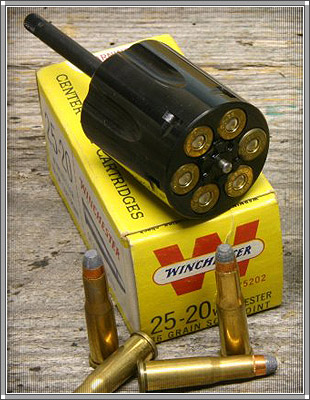
Auxiliary cylinder in .25-20
Available in both blue and stainless, we also have a few unfluted ones.
The gun shown here is an M19 fitted with a 6-in. late-model M17 barrel with the full underlug which is rebored to .25 caliber. In addition to the unfluted .256 cylinder, we’ve added a retro-style .25-20 fluted cylinder with the black powder cylinder chamfer.
In our experience, the Bee is superior to the .22 Jet in performance with velocities around 2000 fps usually possible with 40 gr. bullets in longer barrels. The same is true of the .256 with its heavier 60 gr. bullets. With frangible jacketed bullets, this is still fearsome performance on small varmints. Needless to say, eye and ear protection is obligatory lest you end up bleeding from ears and nostrils from the sonic muzzle blast and report.
Finding suitable barrels can take a bit of doing as all S&W usually has available now are full-underlug barrels. We have a modest stock of M17, M48 and M53 barrels at hand just for these conversions. Somewhere in all of the various S&W models and parts, there is a combination of parts and finishes to satisfy most any craving. Incidentally, we anticipate having extractors with right-hand threads for vintage ejector rods. Once in hand, we’ll be finishing out a pre-war .25-20 M&P with appropriate target sights and a 5-in. barrel. For additional information on K-frame caliber conversions, please see the regular website catalog at the Smith & Wesson Revolvers section at the Packages subsection. There is a link to additional information on labor and prices to build these guns. In any case, please feel free to get in touch with any questions.

MAY 2010, RETRO .38-40 Vaquero — Before fancy adjustable-sight single-action revolvers came along in the ’50s and ’60s, serious single-action aficionados who wanted adjustable sights had little to choose from except the pre-war Smith & Wesson rear sights. While these are small and dainty by comparison to today’s precision click-adjustable sights, they were functional and afforded a far better sight picture than the Colt SAA top straps.


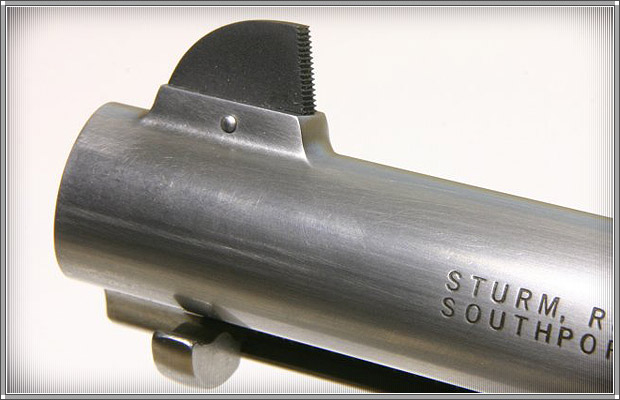
When deployed on S&W double-action target models and registered Magnums, these sights are beautifully integrated into the top straps and are arguably the nicest looking adjustable sight arrangement known.
Early single-action S&W sight installations are not unknown but most are rather simple efforts with little regard to appearance. Typically, the sight tang slot follows the original sight groove. The sight tang usually stops short of the end of the sight groove about where the front strap starts to flow down towards the barrel, not a terribly attractive or refined arrangement. Further, the top strap tapers similarly at the breech end which leaves the blade holding portion of the sight body high and dry with an abrupt transition from strap to sight body at the leading edge.
Clearly Colt did not design the SAA with adjustable sights in mind. The eventual Flat Top Target models were quite different in form and sported a simple dovetail windage-adjustable rear sight. Smith & Wesson, on the other hand, found, by accident or design, that the M&P model fixed-sight top straps would accommodate adjustable sights easily and attractively. Happily enough, so could fixed-sight single-action revolvers.
This particular installation is on a stainless steel New Vaquero in .38-40 caliber. In order to achieve an attractive sight installation, the front and back ends of the top strap were welded and built up enough that the whole of the top strap line would be parallel to the bore without the usual tapering down at either end. The receiver ring just aft of the barrel was machined round and a fillet running up to the top strap just as on Smith & Wesson fixed-sight guns. These two simple modifications result in an especially handsome single-action top strap with or without an adjustable sight. The addition of the sight (from David Clements of Clements Custom Guns) adds a bit of flexibility and precision in sighting. In keeping with the top strap style, the round 4-5/8 in. barrel features an integral front sight base with a serrated ramp blade pinned into place. Vintage style refinements in the form of scalloped receiver and loading gate, black powder cylinder chamfer, lanyard ring and the Bisley-spur hammer are also added.
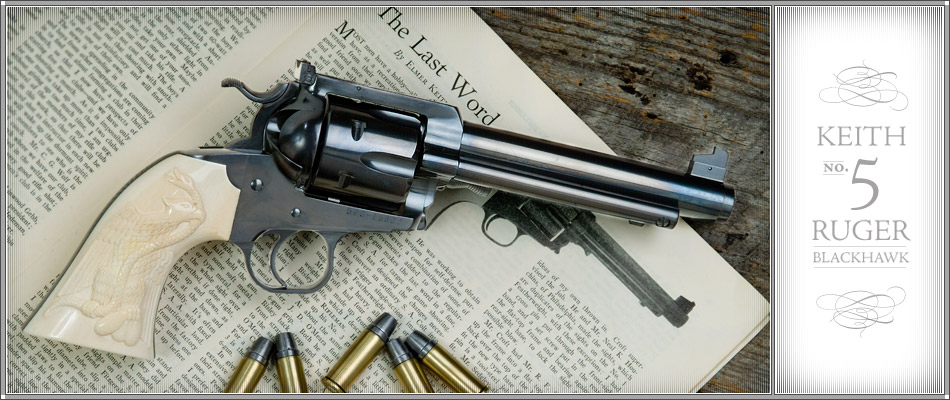
APRIL 2010, KEITH NO. 5 STYLE RUGER BLACKHAWKS — The distinctive Keith No. 5 revolver needs little introduction to the True Believers. It is an icon and blazed trails we still ply today. The original gun was built on a Colt SAA model, a gun that today is itself especially collectible and best left alone. Faithful reproductions of the No. 5 are best done on the USFA Flat Top Target models but these renderings tend to be time-consuming and complicated to build and require a costly gun and parts going in. Accordingly, we set out to build a gun that captured the flavor of the original but didn’t bankrupt owners and builder alike. Auspicious developments from Ruger and Power Custom(operating now as Grand Masters L.L.C.) made such a revolver feasible.
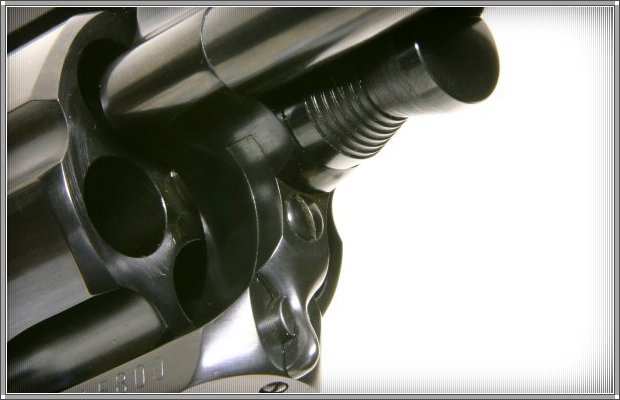
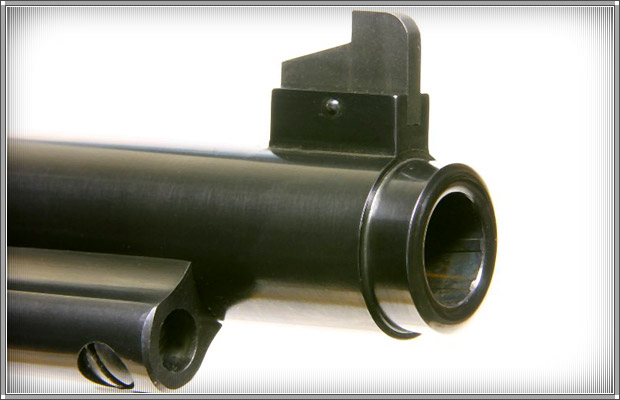
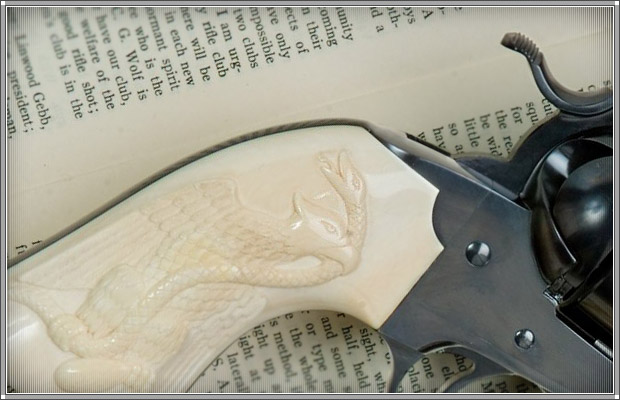
The New Model Ruger Flat Tops, both .357 and .44 calibers, along with the vintage Flat Tops, are well suited to this enterprise with their medium-size receivers and top straps. The factory rear sight, though not faithful to the original gun, is small and well integrated and a reasonable compromise in terms of appearance and cost. Even old Flat Tops are not terribly expensive and are still plentiful. Parts are tough and available. The newly introduced Power Custom No. 5 style two-piece grip frames are at the heart of these projects and simplify production of the No. 5 grip frames. Heretofore, makers had to fabricate back and bottomstraps from existing parts, a tedious undertaking.
The same can be said for the Old Model Bisley-spur hammer without which such a project would look quite naked and unfinished. No trouble to fit a modern Bisley hammer to New Model versions. Ron’s parts eliminate the blacksmithing. The grip conversion will include remachining the bottom strap and a dome-headed screw. The straps will be precision ground for best grip panel fit.
One of the most distinctive and important features of the original gun was the novel lever base-pin latch and hourglass-shaped base pin. The outsized head of the base pin made removal easy; the lever latch was proof against pin-pulling recoil and a real improvement over the Colt arrangement. Installation does, however, require a good deal of work. Indeed, this feature will entail more time and effort than the whole rest of the project to complete as there is a good bit of welding (and heat-treat draw), fabricating, shaping and fitting of a several small parts. Beyond the basics, the only other metalwork is the front sight. While the original featured a Colt New Service elevation-adjustable sight, the Bowen Classic Arms Ruger version will utilize a Flat Top Target style base with a pinned blade shaped much like the originals. This is a much hardier arrangement and far less costly to produce. The barrel forward of the crown is turned down to give the appearance of the original muzzle which was machined to accommodate the sleeve with the sight.
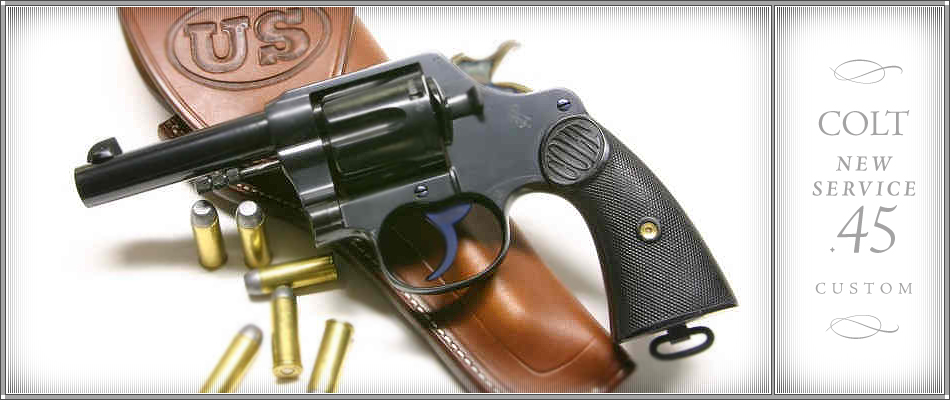
JUNE 2008, COLT NEW SERVICE .45 CUSTOM — Bowen Classic Arms Corp. has had an abiding interest in the great American big-bore factory revolvers of the old days. We have for years offered custom caliber and upgrade conversions on vintage S&W revolvers, particularly the Smith & Wesson .38/44 Heavy Duty models which make such wonderful and purposeful .45 Colts, a caliber S&W offered only in exceedingly small numbers. Originals probably number in the few dozens making them exceptional collectors pieces on the rare occasion one surfaces.
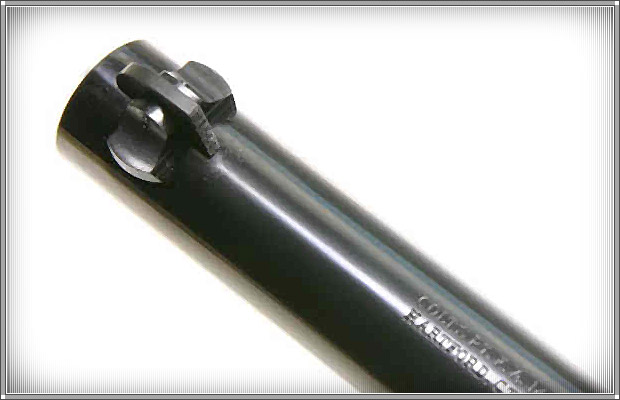
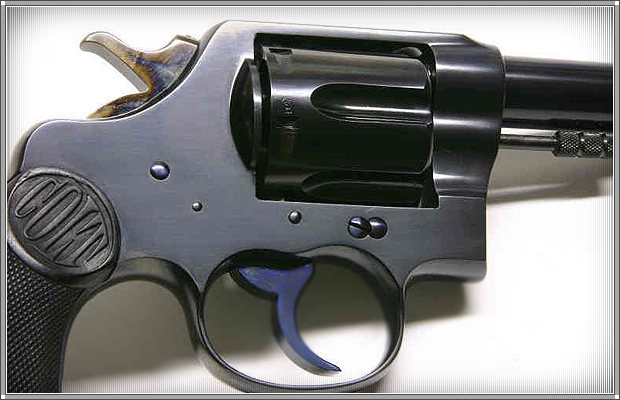
Due to our relative inexperience with the early Colt double-action lock work, we have shied away from working much with them over the years. All of the folks we know who were fluent in action building and tuning are dead and took their knowledge with them so we have always been a bit leery sticking our oar in where we didn’t know what we were doing. Practicing on other folks properly is not a great idea. But, occasionally petty rules are for the breaking. We were presented with a tired but serviceable .455 New Service that had been converted to .45 Colt reasonably well many years ago. The lock work was in first-class condition with a tight even double-action cycle and nice, crisp 4-5 lb. single-action pull. No room for improvement and no remedial work indicated so we were able to undertake the finishing on a sound foundation.
The gun was completely hand polished and any visible and savable markings recut, including the rampant Colt and several proof and military markings. The barrel was shortened to 4 inches and rollmarked with Colt SAA markings by Turnbull Restorations. Not quite authentic but proper and attractive never-the-less. Our little Colt-style single-action front sight completed the barrel work. The cylinder received the usual black powder cylinder chamfer. All the screws, pins and trigger were nitre blued and the hammer color cased. It isn’t often that you find decent original hard-rubber grips so the owner resorted to some reproductions which, with a bit of fitting and tinkering, turned out surprisingly well. Ivory grips on one of these would be stunning. At the end of the day, the owner ended up with a right handsome old Colt.
Thad Rybka produced the military style holster. We‘re looking for a couple more in rimmed calibers in decent shape mechanically with minimal external goobers to try a couple more. Also need a domestic target version in any caliber with the adjustable sights all there and working. Export versions have non-adjustable sights with a pinned front blade and dovetail rear. Blue and bore condition not important. In view of the increasing shortages of suitable S&Ws, these big Colts are an attractive and fascinating alternative for a shooter or collector who wishes to have a fine old big-bore revolver.
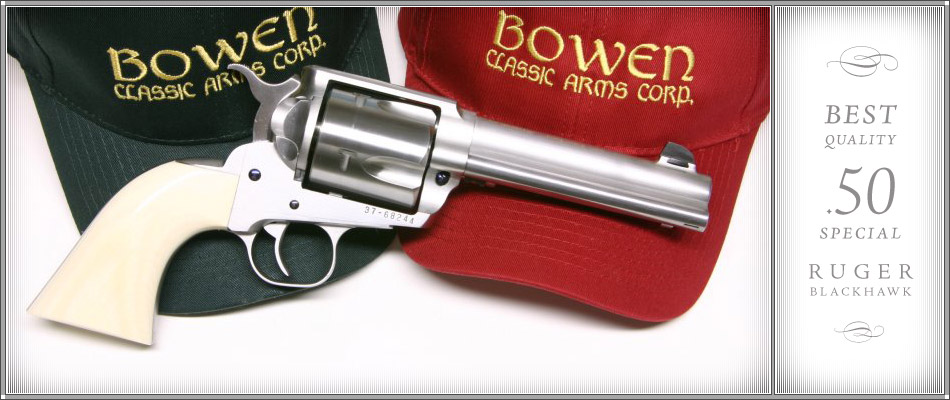
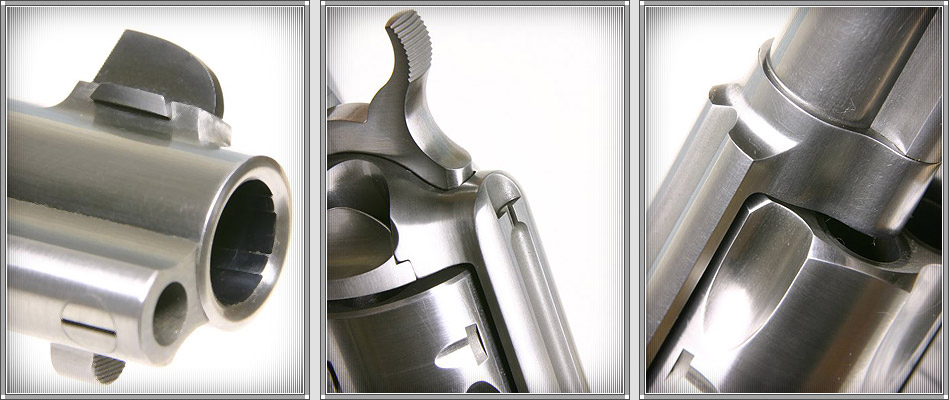


May 2008, Best-Quality
.50 Special Ruger Blackhawk
This old fellow passed through the shop this month; couldn’t let it get away without making a few photos and comments. Not much to be said except that this is the 15th ‘best-grade’ gun we’ve built and, perhaps, our favorite.
Build on a chromoly .357 large-frame Blackhawk, the top strap was welded and re-machined in the S&W M&P style which, in our view, is the handsomest top-strap treatment there is for single-action revolvers.
Usual other refinements include scalloped recoil shield and loading gate, narrow Super Blackhawk hammer, dovetail front sight in an integral base and the regulated/ blended ejector housing screw.
The two-piece Power Custom grip frame accommodates a set of lovely one-piece ivory grips from Paul Persinger. The finish is a fine brushed surface with the screws and pins
nitre blued.
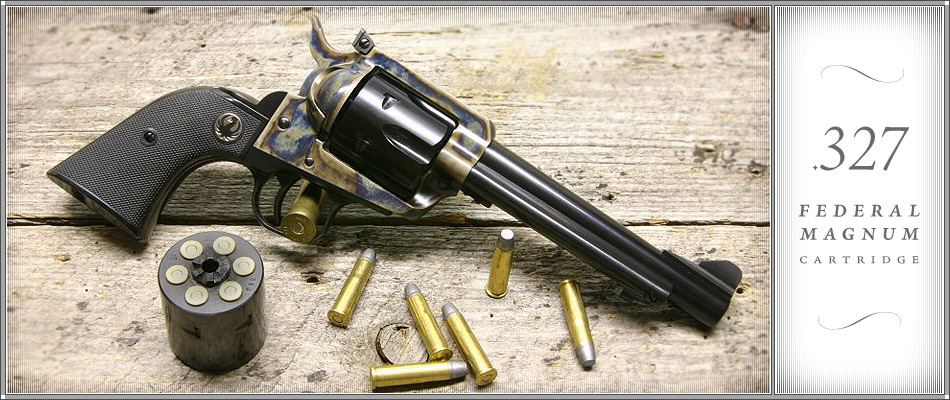
A New Model 50th Ann. .357 Flat Top conversion to .32-20 with an auxiliary unfluted .327 cylinder.
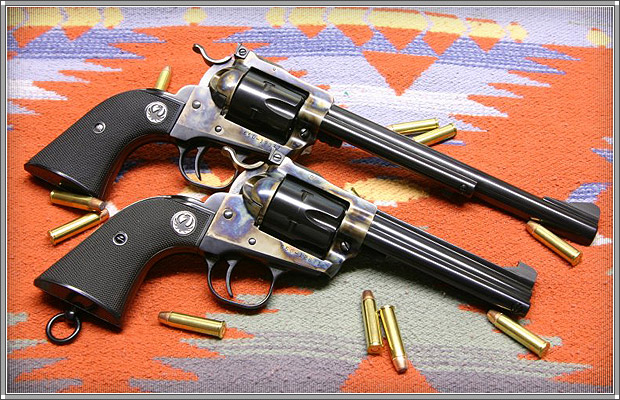
A couple of .327 Single-Sixes. The 7-1/2 in. gun has a line-bored cylinder. The 4 in. gun sports a rebored S&W K22 barrel.
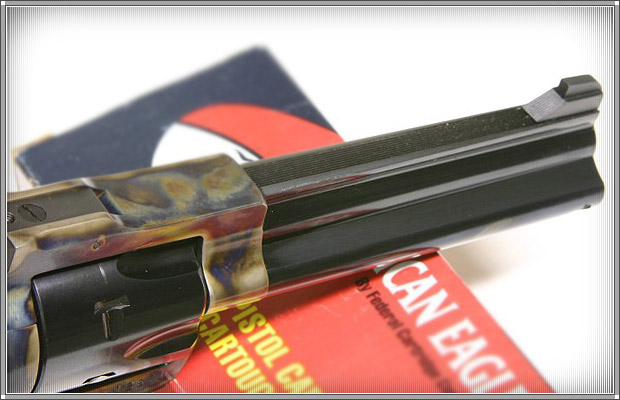
Another view of the K22-barreled Single-Six.
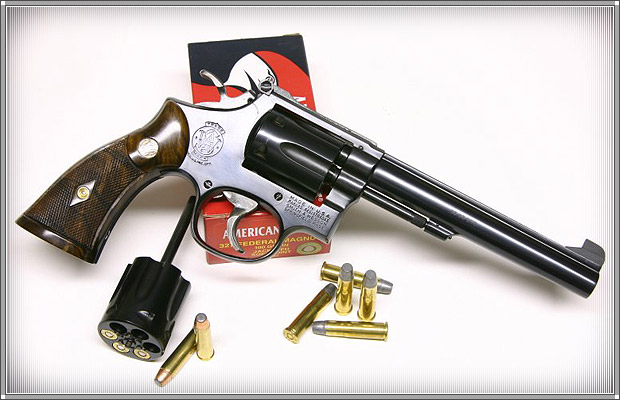
K-frame Smith & Wesson with interchangeable cylinders in both .32-20 and .327 Federal Magnum; Lovely factory-style French walnut grips are from Keith Brown.
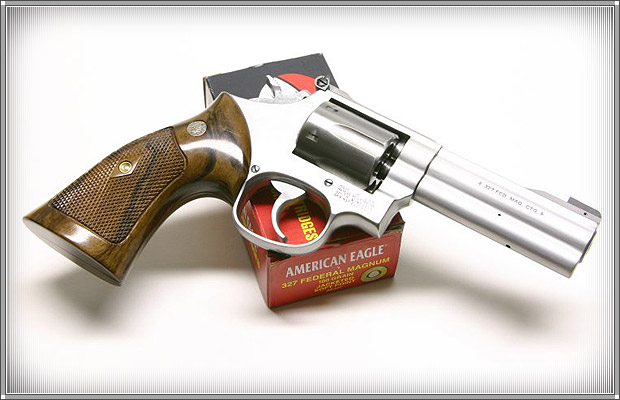
Smith & Wesson M617 .22 barrels and cylinders are still available and were applied to this .M66.
May 2008, .327 Federal
Magnum Cartridge
Those of us who are serious small-bore, small-game revolver enthusiasts have clamored for years for the moral equivalent of the great old .32-20 but in a more modern, tougher, available package. The cartridge fairies have been listening and have come through in grand style. The .327 Federal Magnum will perform every bit as well as hand-loaded high-pressure, high-performance .32-20 loadings. Better still, the .327 is nothing more than a stretched .32 H&R Magnum which means it is quite small in diameter and can be built in 6-shot guns on relatively small frames, places the longer, larger .32-20 just wouldn’t fit easily (or cheaply).
For reasons known only to the fine folks at Sturm, Ruger & Company, the .327 has ended up in their small double-action SP-101 rather than in the Single-Six. While the SP-101 is a hardy little double-action gun, many of us really, really wanted to see the gun in a small single action. The .327 will work fine in a slightly longer cylinder body section with virtually no other modifications. The walls and webs of the factory .32 H&R cylinder are thicker than many .357 Magnums so there is no reason to go to a more costly and complicated 5-shot part.
Bowen Classic Arms is adding the chambering to our line-up and will offer Single-Six and medium-frame Blackhawk and Flat Top single-action revolvers in this great little cartridge. We’ll have a semi drop-in cylinder available under the RS06 catalog number for the .32 H&R Single-Six model that will utilize the original barrel suitably modified for the long-body cylinder. The receiver will be properly marked as to caliber and then re-blued. We’ll also offer a more sophisticated version similar to our ‘Long Hunter’ package per catalog number RS07 which will feature a line-bored cylinder, custom barrel and the usual trimmings. We’ll also note the availability of 6-shot line-bored conversions with factory-style cylinders in conventional calibers in all of the New Model size receivers.
We’re hoping to have our initial run of cylinder blanks available this summer. As an aside, these same blanks will enable us to offer tight-chamber .22 rim fires. .22 and .25 caliber wildcats based on the .327 are contemplated, as well. We’ve done a few Smith & Wesson K-frame guns in .327 which have proven wonderful shooters. Unfortunately, the better cylinders for re-chambering are the scarce older K22 parts. As the supply is fading fast, we’re working to produce a long-body K-frame S&W cylinder which we can utilize not only for the .327 but also the .32-20, .218 Bee, .25-20 and .256. For M53 enthusiasts, we will be able to fashion an auxiliary .22 LR cylinder. As long as we can get our paws on K22 barrels, which should be in S&W part bins for a while now, we’ll be able to produce the lovely K-frame M14s and M15 in a variety of great small-game and plinking rounds, including the .327 It is not often that we have a new revolver cartridge to get fired up about but the .327 Magnum is the most important mainstream cartridge offering since the .44 Magnum for serious revolver nuts.
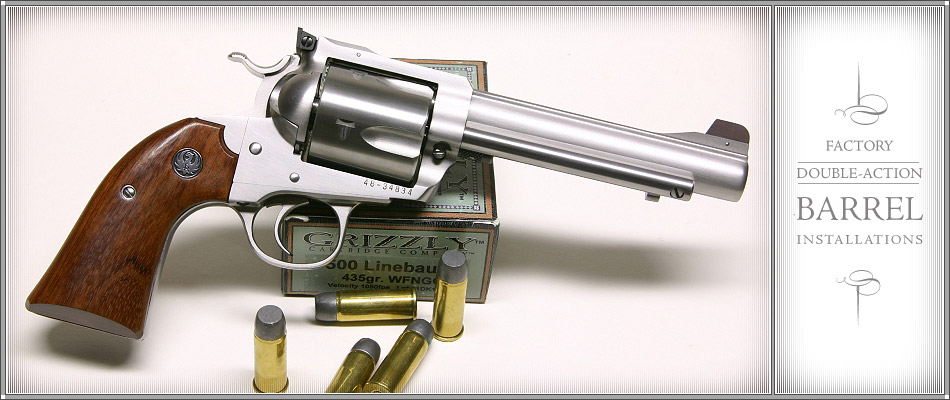
.500 Bisley with S&W barrel
March 2008 FACTORY DOUBLE-ACTION BARREL INSTALLATIONS — In the Bowen Classic Arms shop, the vast majority of custom barrel installations involver the various Ruger revolvers we work on. Only rarely do we replace or fabricate barrels for S&W revolvers. That said, not all custom barrel installations involve custom fabricated barrels. Some useful barrels come right out of the factory parts bins; we’ll touch on a couple of house favorites.
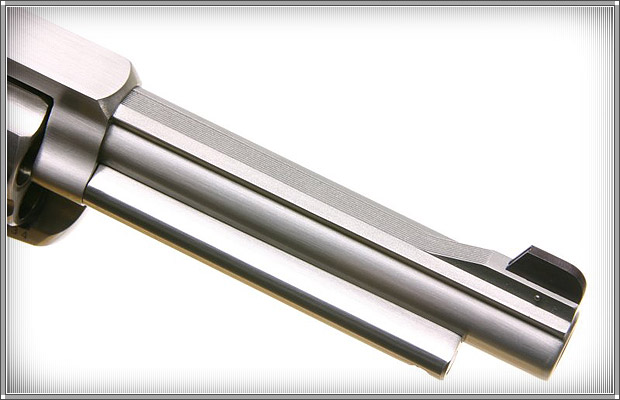
.500 Bisley Rib and Sight details
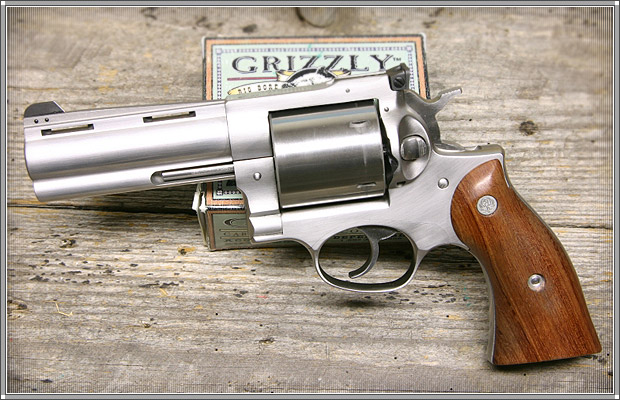 5-shot .45 Colt Redhawk with a 4-1/4 in. Colt Anaconda barrel.
5-shot .45 Colt Redhawk with a 4-1/4 in. Colt Anaconda barrel.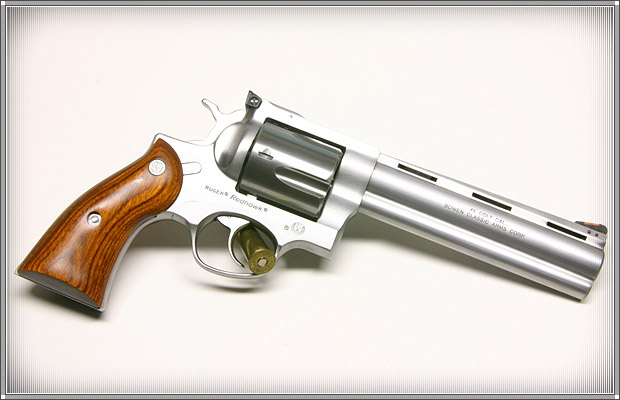
5-shot .45 Colt Redhawk with a 6-1/4 in. Colt Anaconda barrel.
Of all the barrels a custom revolver builder can fabricate for single-action revolvers, one of the most complicated shapes is a round barrel with an integral rib. Most of these barrels we’ve made from scratch over the years ended up faithful copies of S&W barrels. After a while, that little light bulb that occasionally flickers in the back of one’s head glimmered a little brighter than usual one day and it occurred to us that, where possible, why not just use S&W bbls. And, as the fates would have it, factory S&W barrels happen to be of nearly perfect diameter and contour to work on most Ruger single-action revolvers without recourse to far more costly custom pipes. There are few limitations but not many. Obviously, the barrel length and caliber you want has to reside within the contours of factory parts. For large-frame Rugers, SAs, the traditional N-frame Target model barrels found on the M25, M29 and M57 guns and their stainless counterparts will yield wonderful barrels in virtually all lengths from 4 to 7-1/2 inches. Thanks to the fine folks at Delta Gun Shop, we can rebore these on up to .475 and the various .50 calibers if need be. We have a .327 Single-Six underway that will utilize a rebored K22 barrel.
Fitting up a S&W barrel to a Ruger single action is a fairly simple and straight-forward undertaking. First order of business is to machine of the underlug and then file and polish to round that section of the barrel. Now is also a good time to remove the lettering. Next, the S&W barrel shank threads are too small so a Ruger-size shank and threads must be turned at the appropriate point to yield the required length. The 8-3/8 in. barrels will yield up to 7-1/2 in. lengths in most cases; the 6 in. tubes will get you 4-5/8 and 5 in. finished barrels. All that remains now is the usual fitment of ejector tube, crown and finishing. In standard calibers such as the .44 Magnum, often as not, the existing front sight height will regulate properly. If not, simply pinning in a taller blade will do. The only wrinkle that occasionally raises it head is the receiver face. If the top strap is heavily beveled, the top strap nose has to be welded up and recontoured to prevent a step between the rib shoulder and breech face.
Not all double-action barrel conversions are limited to single-actions. One of the most handsome and unique is the installation of a Colt Anaconda barrel on a Redhawk. Installation procedure is much as it is with single-actions except that we leave the under-lug and re-machine the ejector slot to accommodate the Redhawk’s ejector. Welding up the receiver nose isn’t necessary though the rib must be sloped to meet the receiver face. Since the barrel shoulder has to break at a rib post for proper strength and appearance, 6 in. barrels will yield 4-1/4 in. finished barrels; 8 in. 6-1/4 in.
These installations represent a considerable savings over custom-fabricated barrels. Most installations run around $500–$600 plus the barrel though, where welding is involved, the cost is up a bit since we also have to draw back the receiver in the heat-treat furnace after welding and then do the file and polish work. At this writing, Brownells has a few 6 inch. Anaconda barrels and 8-3/8 in. S&W M29 and 629 barrels. Most other calibers and lengths are catch as catch can. While this is not a cataloged item, we are happy to produce these on a regular basis, assuming we can come up with appropriate barrels.
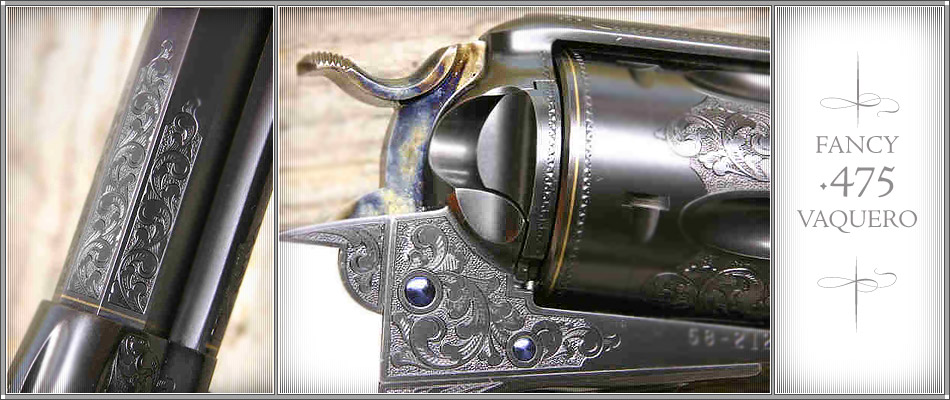
JANUARY 2008, FANCY .475 RUGER VAQUERO — This was a relatively ordinary gun until the finishers got hold of it. Starting life as some sort of Ruger Vaquero, we applied a .475 Linebaugh conversion with a few refinements to the metalwork in the form of a scalloped receiver/loading gate, fluted cylinder and an octagonal barrel with in integral front sight base. Nice enough but it is easy to see how a little bit of additional embellishment can produce a gun that is especially lovely. Paul Persinger made the exquisitely fitted and shaped ivory grips. Dan Love executed the simple, yet tasteful engraving with a few modest touches of gold showing through. Turnbull’s colored the hammer and nitre blued the screws and pins. The peacock blue bits show very nicely against Charles Danner’s rust blue. Nothing loud, nothing flashy but particularly handsome.
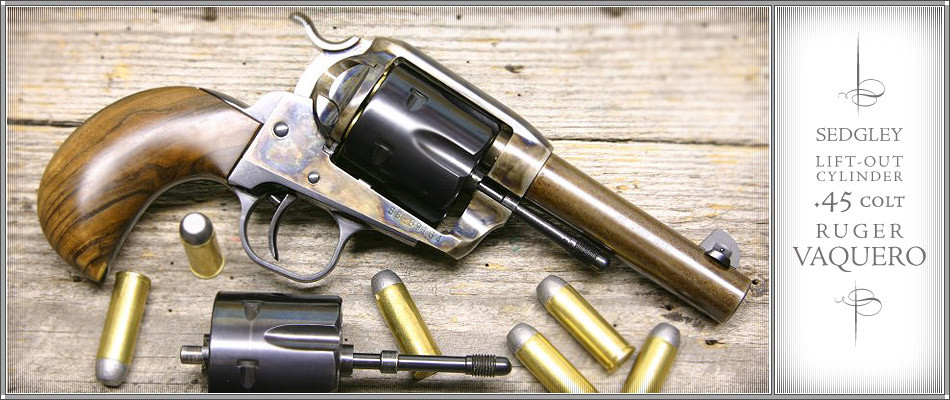
SEDGLEY LIFT-OUT CYLINDER .45 COLT RUGER VAQUERO — R. F. Sedgley was one of the most prolific American gunmakers and exerted a great deal of influence on the trade, particularly between the World Wars. Best known for his Springfield and Mauser sporting rifles, he also dabbled in handguns. Many of the famous revolvers conceived and owned by Elmer Keith, including the famous No. 5 gun, reflect Sedgley’s handiwork and insight.
Among the least known of his designs are the lift-out cylinder single-actions. Known examples are all based on Colt SAA guns suitably modified to contain what is essentially a double-action cylinder with an extractor and extractor rod for simultaneous ejection. The rod is pulled forward freeing the bolts so that the cylinder can be removed through to loading gate. Clever and cool if not markedly faster in the loading and unloading.
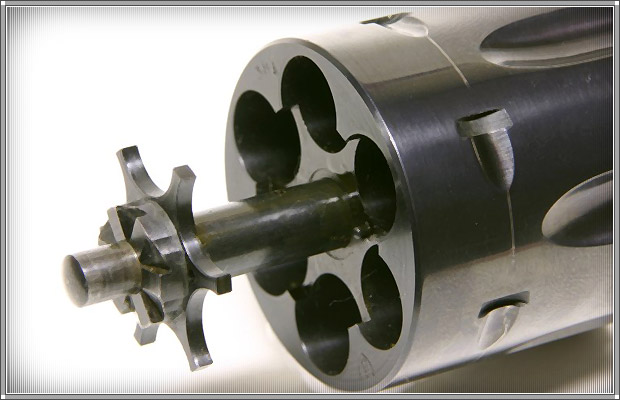
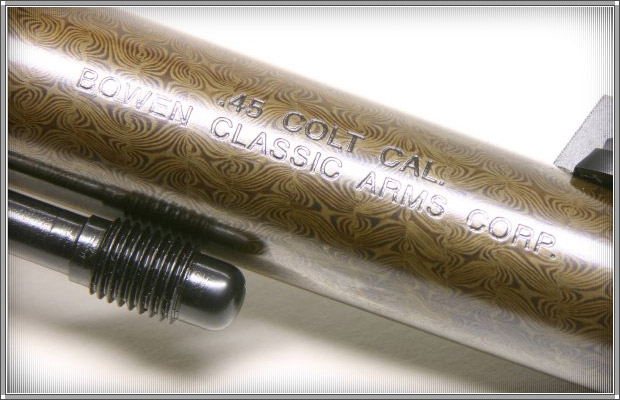
Bowen Classic Arms has built several of these guns over the years, all based on Ruger Vaqueros. Several have had extra cylinders. This particular specimen is rather more interesting than usual by virtue of its browned damascus barrel. The Power Custom two-piece grip frame has been round-butted and is fitted with a set of one-piece fancy French walnut grips from Roy Fishpaw.
Other features include tuning, coloring, Bisley-spur hammer, scalloped receiver/loading gate and a dovetail Colt-style front sight. We’re hoping to start this year on a version of this gun built on a USFA SAA model as were most of the originals. Sedgley’s lift-out cylinder revolvers represent an interesting if not terribly useful development and are now largely regarded as rare and wonderful curiosities to serious revolver aficionados.

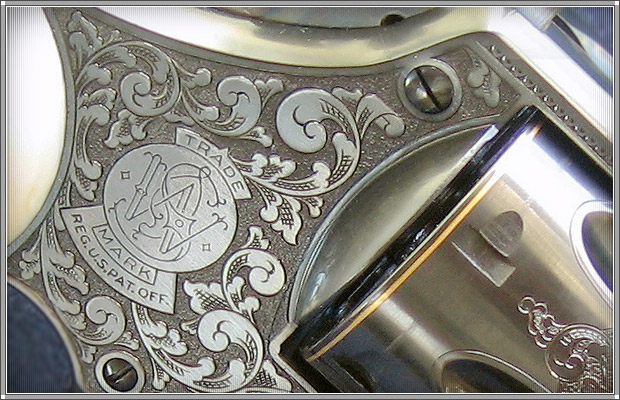
APRIL 2007
Another Engraved
Smith & Wesson N-frame
Not much to be said about this gun except it is a sexy as a three-dollar firecracker. Starting life as an ordinary .38/.44 Heavy-Duty model, this gun was converted to .45 Colt. Dan Love did the wonderful engraving; Paul Persinger pleads guilty to the steer-head grips. Dan and Paul have an unseemly amount of talent between them. In combination, their work is stunning. Photos courtesy of owner.

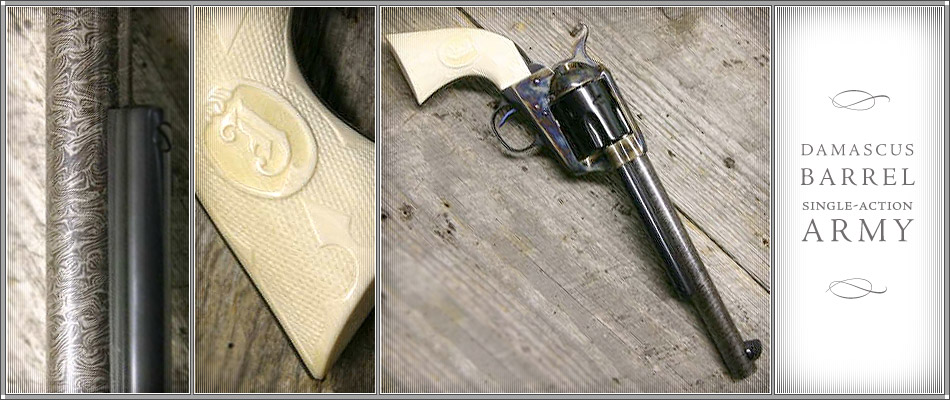
April 2007, Damascus-barrel Single-Action Army — Damascus steel is one of the loveliest and most beautiful materials found in gunmaking. Not nearly as strong as fluid steels, damascus barrels largely disappeared with the advent of smokeless powder. While never used on single-action revolvers, damascus barrels have been used on more modern firearms than one might imagine. The best example is the M1897 Winchester pump shotgun. Damascus barrels were available as an extra-cost option for several years, right on into the twentieth century. These guns are extremely rare since nobody wanted to pay extra for obsolete technology.
Colt produced a number of smooth-bore Single-Action Army revolvers for aerial trick-shooting which begs the question why some weren’t made with damascus barrels since many shotgun barrels of the day were of damascus steel. Colt didn’t make one, but that’s no reason not to have one now. Bowen Classic Arms has made several over the years both with ‘Paradox’ rifle chokes and fully rifled .45 Colt barrels. These are made with modern fluid-steel liners entirely strong enough to function even without the thin, outer damascus sleeve.
This particular gun started life as United States Firearms Single-Action Army model in .45 Colt. The composite damascus barrel sports an overlay of English gun tube material browned in the traditional ‘salt and pepper’ colors of vintage Parkers which makes for an unusual and especially handsome finish. The front sight is our traditional Colt-style dovetail base with pinned blade. Turnbull Restorations did the coloring. The checked ivory grips were produced by Paul Persinger with a monogram of the owner’s initials. One of the nicer single-actions we’ve done in a while.
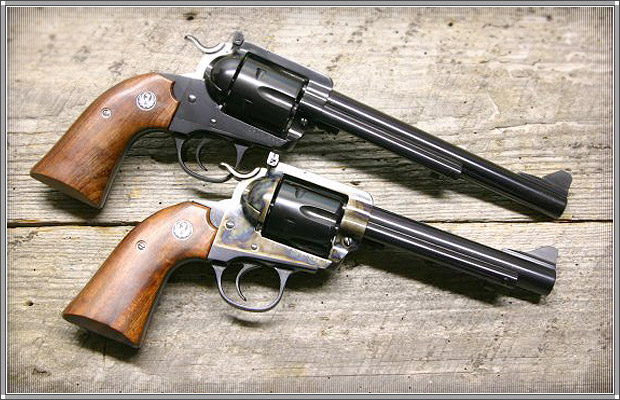
.44 Special Flat top Bisleys

.45 Colt Flat Top Bisley
February 2007, Ruger New Model Flat Top Bisleys
The two most exciting Ruger revolvers introduced in years are the 50th Anniversary Flat Tops in .357 and .44 Magnum. Naturally, they are very closely related to their Blackhawk and Bisley cousins; parts are largely interchangeable.
Converting the Flat Tops to Bisley configuration was an obvious notion and one that renders a handsome and handy single-action revolver. For whatever the reasons, the Bisley grip frames mate to the Flat Top receivers better than the standard Blackhawks. Even the safety locks integrate well into the Bisley grip frame with a few simple milling machine cuts.
The two revolvers shown started life as .357 Magnums but are now .44 Specials. The color cased gun is fitted with a 5-1/2 in. barrel, the blue gun a 7-1/2 in. barrel. The Bisley parts conversion is applicable to the new Flat Tops and is now a standard catalog item per cat. no. B410 in the ‘Options’ section of the Ruger Single-action Revolvers portion of our on-line catalog. All of our caliber conversions, whether the RS05, RS06 or the big-bore RS07 are suited to the New Model Flat Top revolvers. Since many of the RS05 Simple Caliber Conversions will require longer barrels, feel free to contact us for a quotation on your project.
December 2006, Fancy Smith & Wesson M58 — Seems like we do not turn out many engraved S&Ws but, thanks to the lovely engraving by Dan Love, this one makes us wonder why. This gun started life as an ordinary M58 and then was overhauled to resemble a Heavy Duty model. The receiver topstrap was recontoured to resemble the vintage fixed-sight guns and an original 5-inch HD barrel added and rebored in .41 Magnum caliber. Other touches include tuning, recoloring the hammer and trigger, a black powder cylinder chamfer and a taller front sight blade, serrated and pinned to the existing sight base. While not wall-to-wall, Dan’s engraving is beautifully executed in a style befitting factory S&Ws. There is just enough gold work to give the engraving a bit of fire. The grips are vintage factory N-frame S&W parts.
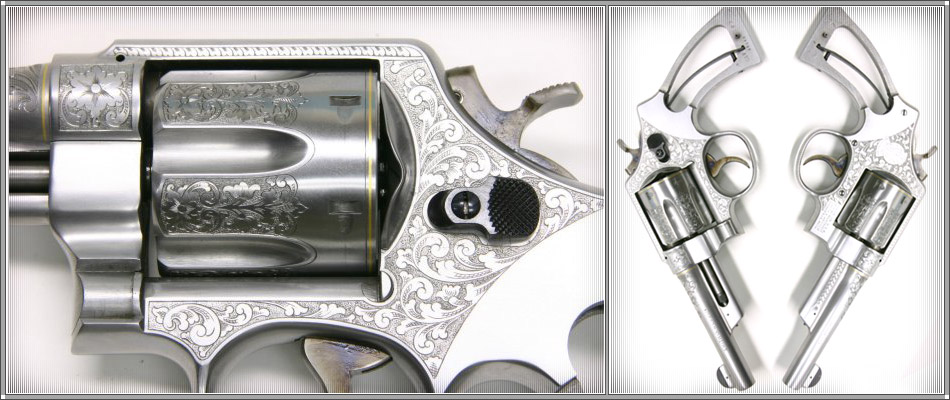
.32-20 Ruger Single-Six — Loaded in a modern revolver with high-performance ammunition, the lowly .32-20 may be best of all the small-bore revolver cartridges. It will shoot 110--115 gr. bullets at least as fast as a .357 Magnum and, since the .32 caliber bullets of this weight have a better sectional density, trajectory is flatter, velocities at longer ranges higher. Recoil is negligible even though muzzle blast can be annoying. It’s hard to imagine a nicer small-game and plinking round. It does have one drawback however. The over-all cartridge length ordinarily limits it to medium-frame revolvers such as the Colt SAA, the K-frame S&W or the .357 Ruger Blackhawks. Well enough but a smaller package would be nice.
 An obvious candidate at first blush is the Ruger Single-Six. Unfortunately, the .32-20 is far too long to fit the receiver and existing cylinders without some modifications. The cylinder window in these little guns is simply too short to accommodate an adequate cylinder. Fortunately, there is enough material in the receiver to open up the window at the front for a proper cylinder. The .32-20 is also just a bit too large to work in the standard 6-shot part so the window must also be opened up to accommodate a 5-shot cylinder of larger diameter. A lot of work but the results are worth it for a real .32-20 nut. The little gun shown here started life as a stainless steel .32 Magnum Vaquero and has been extensively modified to handle the .32-20. The oversize 5-shot cylinder is line-bored to the receiver. The barrel is fabricated from a piece of stainless Douglas .308 caliber stock and features an integral front sights base to which is fitted a drift-adjustable dovetail sight blade in the white-line ramp style for improved visibility.
An obvious candidate at first blush is the Ruger Single-Six. Unfortunately, the .32-20 is far too long to fit the receiver and existing cylinders without some modifications. The cylinder window in these little guns is simply too short to accommodate an adequate cylinder. Fortunately, there is enough material in the receiver to open up the window at the front for a proper cylinder. The .32-20 is also just a bit too large to work in the standard 6-shot part so the window must also be opened up to accommodate a 5-shot cylinder of larger diameter. A lot of work but the results are worth it for a real .32-20 nut. The little gun shown here started life as a stainless steel .32 Magnum Vaquero and has been extensively modified to handle the .32-20. The oversize 5-shot cylinder is line-bored to the receiver. The barrel is fabricated from a piece of stainless Douglas .308 caliber stock and features an integral front sights base to which is fitted a drift-adjustable dovetail sight blade in the white-line ramp style for improved visibility.
The top-strap is machined for a BCA J-frame square-notch/white-outline rear sight, giving the gun a first-class set of sights. The Bisley-style hammer with checkered spur makes for faster handling. The lanyard ring lets you apply a lanyard so you can hang onto it. Tuning, sighting and a set of Roy Fishpaw dall sheep horn grips round out the list of modifications.
Stoked with high-performance ammo, this gun will shoot gas-checked cast bullets at 1400 fps into quarter-size groups at 25 yards. Hard to imagine a better trail/companion gun. Regrettably, it took considerably more time to build this gun than a .500 Linebaugh Bisley so it is unlikely that this conversion will make it into the regular catalog.
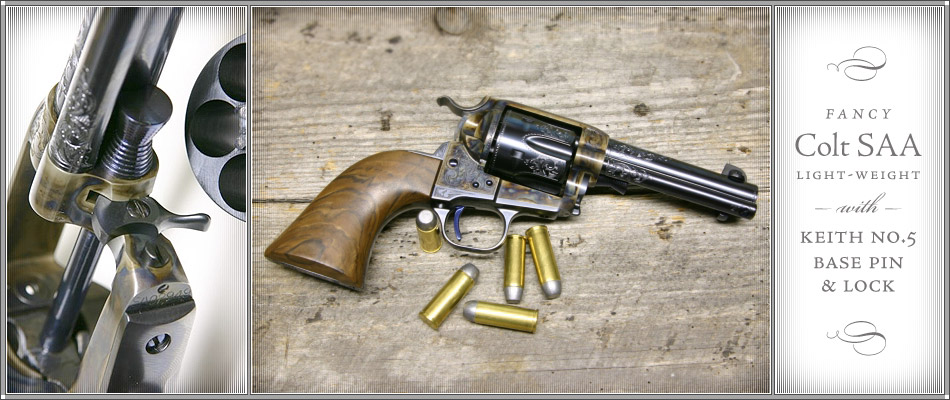
September 2006, Fancy Colt SAA Light-Weight with Keith No. 5 base pin and lock — This Colt Light-weight style gun in .45 Colt is a bit out of the ordinary for several reasons. The metalwork is hand-polished and lightly detailed. Most importantly, we’ve fabricated and fitted a Keith No. 5 style base pin and lever lock. Roy Fishpaw did the one-piece french walnut grips and Dan Love did the engraving. Turnbull Restoration colored the receiver, gate and hammer, carbona blued the major parts and nitre blued the base pin, trigger and screws. A lovely classic custom.
April 2006, The Real Super Redhawk — The Ruger Super Redhawk is neither the handiest nor most graceful revolver around due to the enormous receiver distinguished by the extension around the barrel and the integral scope cuts on the top strap. The Super does, however, have a couple of very real advantages over the standard Redhawk. The Super action is improved with a two-spring lock work arrangement which gives better ignition and ease of tuning. Better double-action hammer and trigger geometry gives a more even double-action cycle. Lastly, the Super receiver has a spike-style grip frame which is available factory-fitted with a couple of different rubber grips which many shooters find more bearable under heavy recoil. With no straps, a custom grip maker can make grips with improved reach, different angle relative to the bore and a host of other subtle adjustments not possible on the standard Redhawk conventional grip frame.
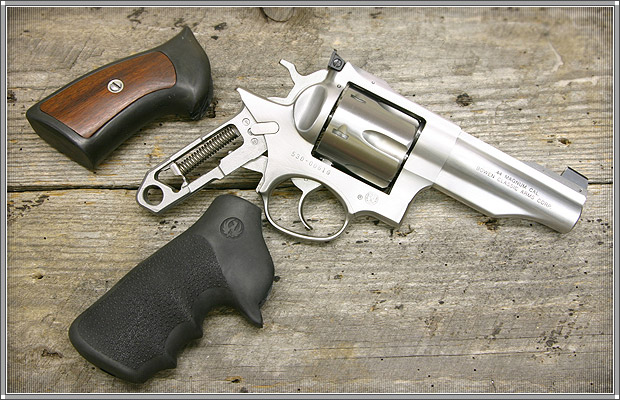
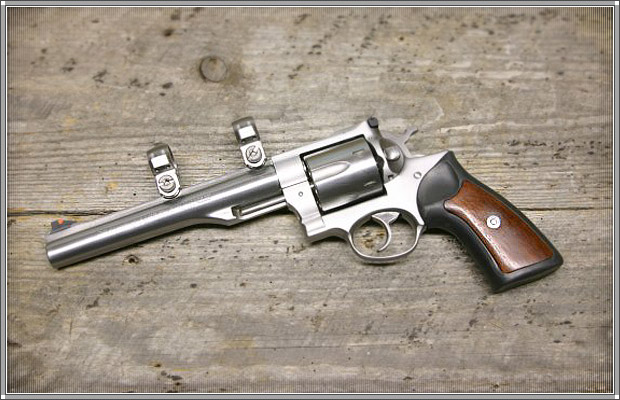
Efforts to produce a more conventional-looking revolver from a Super receiver have generally been stymied in the past by the unsightly integral scope-base cut in the topstrap which ordinarily would require welding to fill which adds a good deal to the time and expense of the project. This is all changed with the advent of the new Super Redhawk ‘Alaskan’ model with its plain topstrap. We have devised the tooling and procedures to remove the original barrel and shorten/recontour the receiver snout to accommodate standard Redhawk barrels which results in a giant GP-100. Now, we have a receiver suited to virtually any modification available for the standard Redhawk. We can build in calibers from .44 Magnum to .500 Redhawk in barrels from 4 to 7-1/2 inches (5-1/2 in. length maximum in .475 and .50 cals.). The only fly in the ointment is the barrel situation. Standard Redhawk barrels are unavailable from the factory so we have to depend on an uncertain supply of take-off and scrounged parts. Accordingly, interested parties need to be on the look-out for barrels. We are also interested in purchasing extra barrels you might find and would appreciate hearing about these.
There are many possible ‘GP-44’ variations so prices will necessarily have to be quoted for each job. As a general rule, the most basic conversion, utilizing the existing cylinder but less barrel price. Now a regular catalog item, details are found at the Ruger Double-Action section of our catalog. There are many possible ‘GP-44’ variations so prices will have to be quoted on an individual basis.
![]()
See more in our GALLERY | For the full story purchase The Custom Revolver






